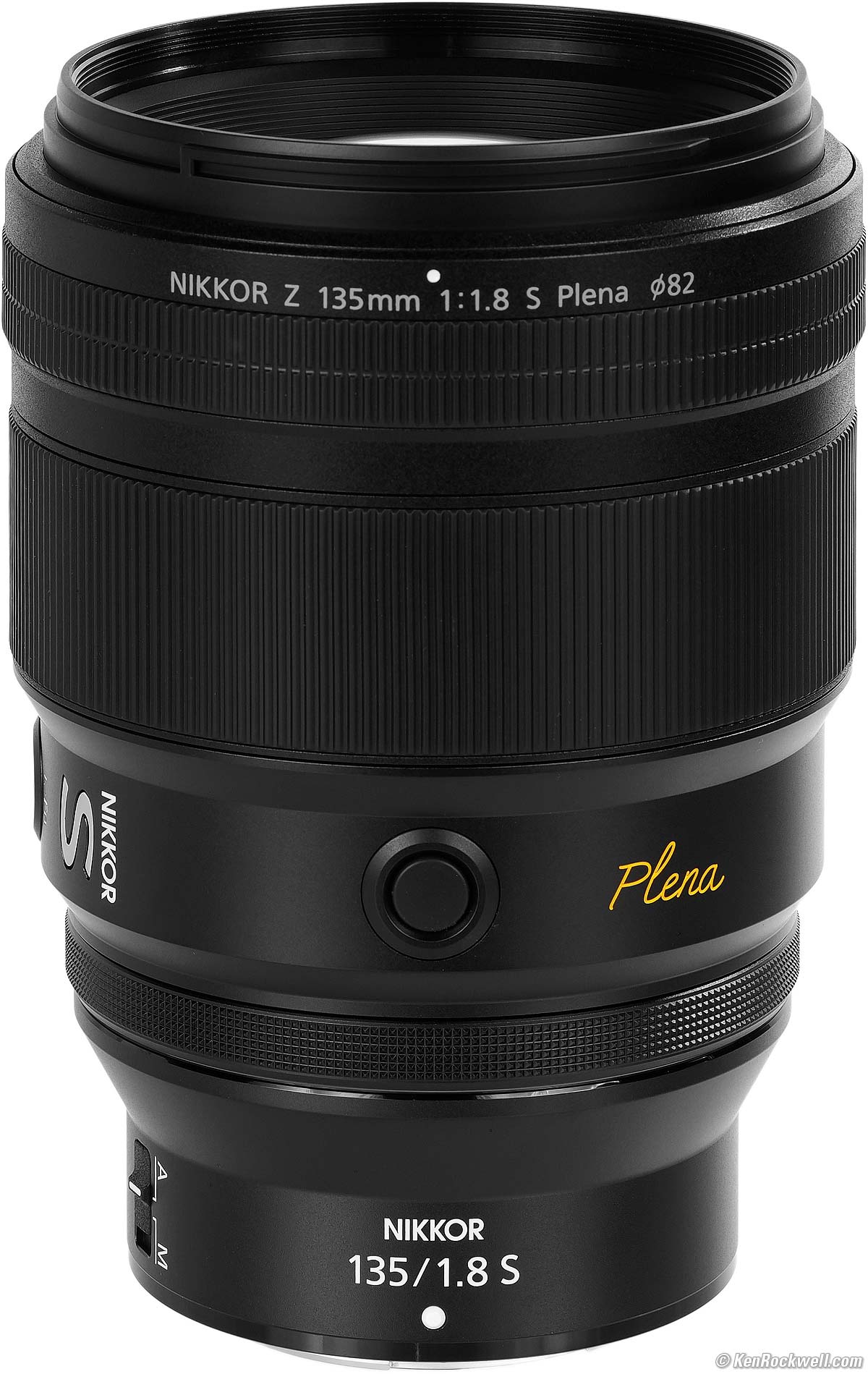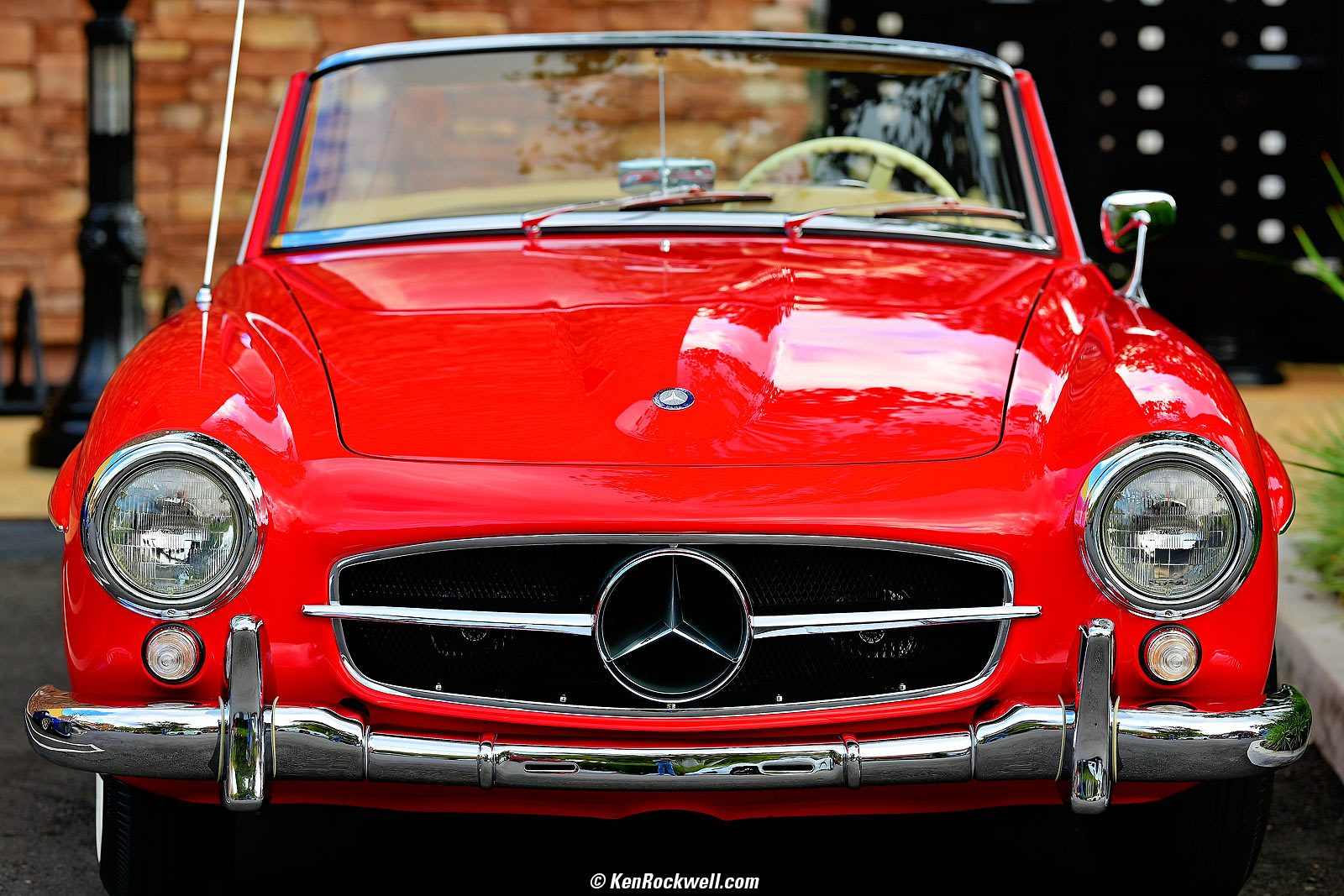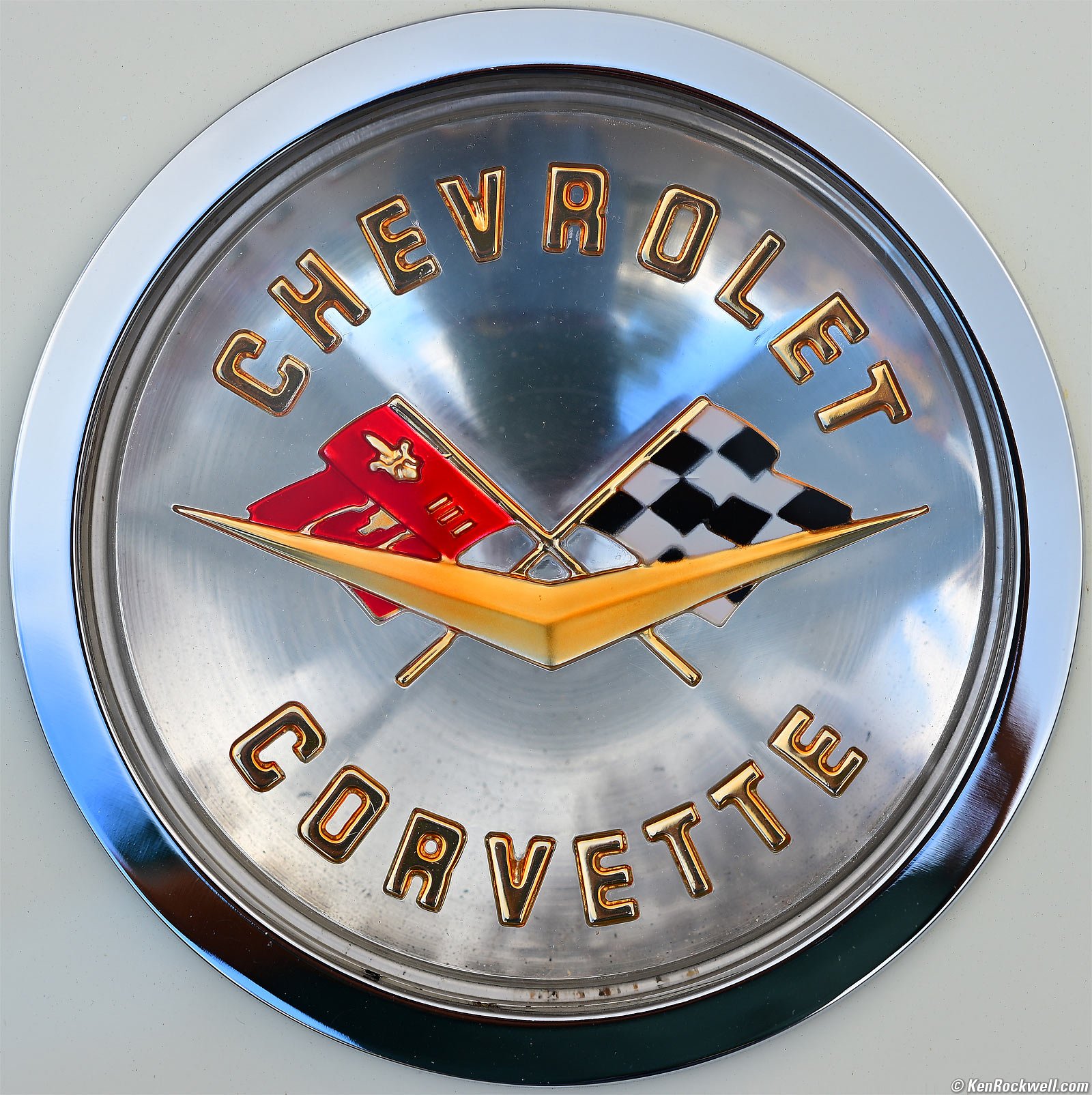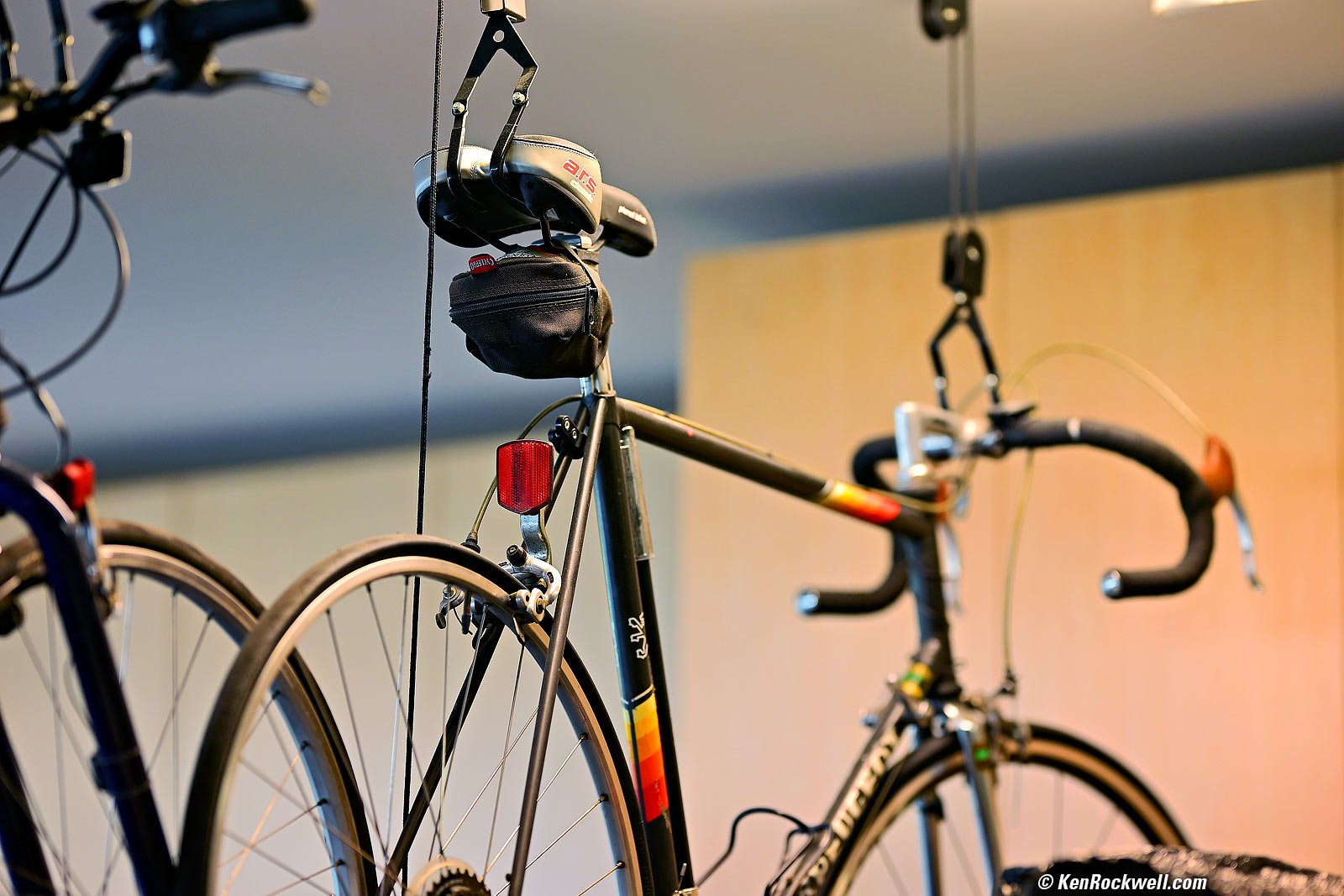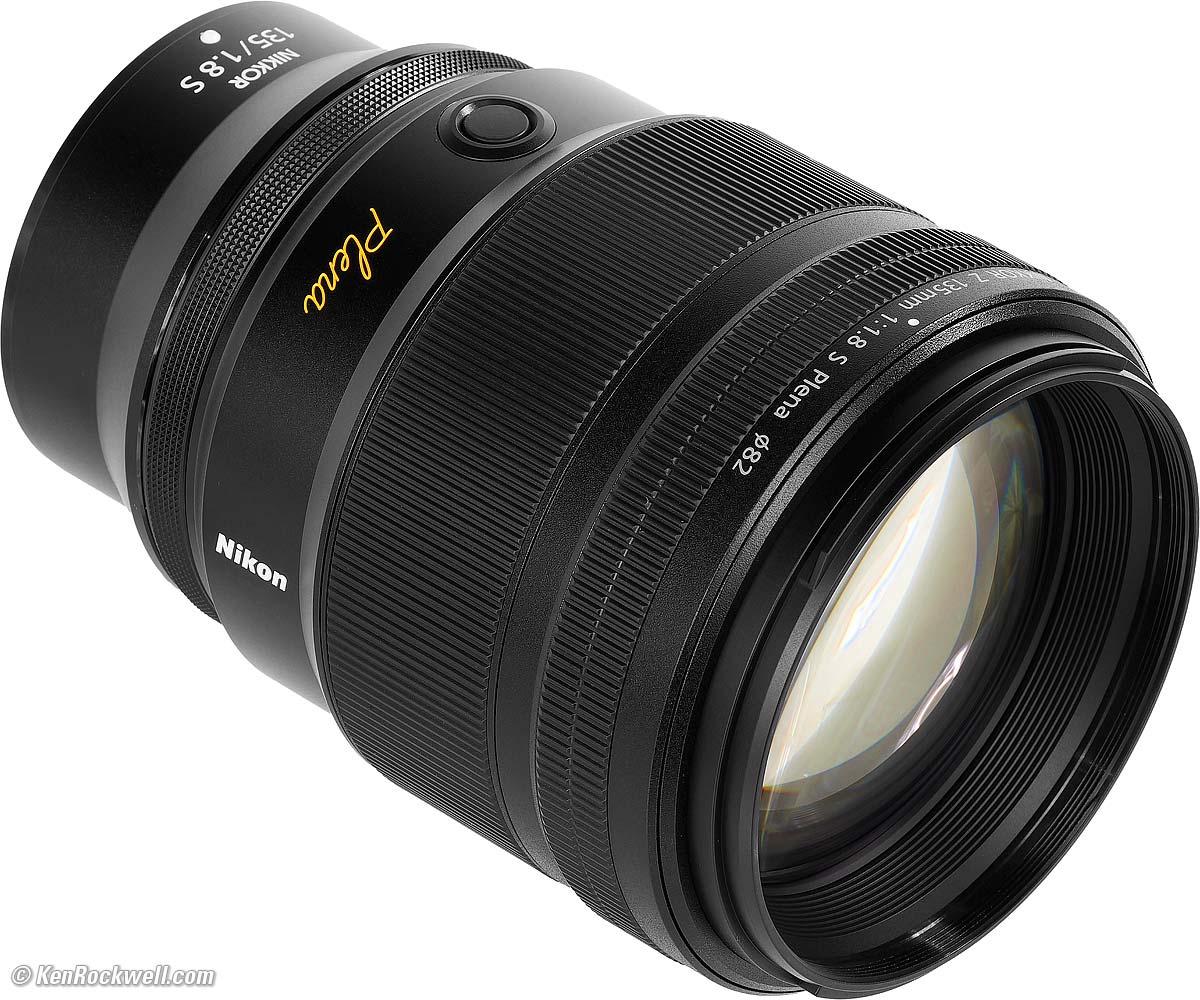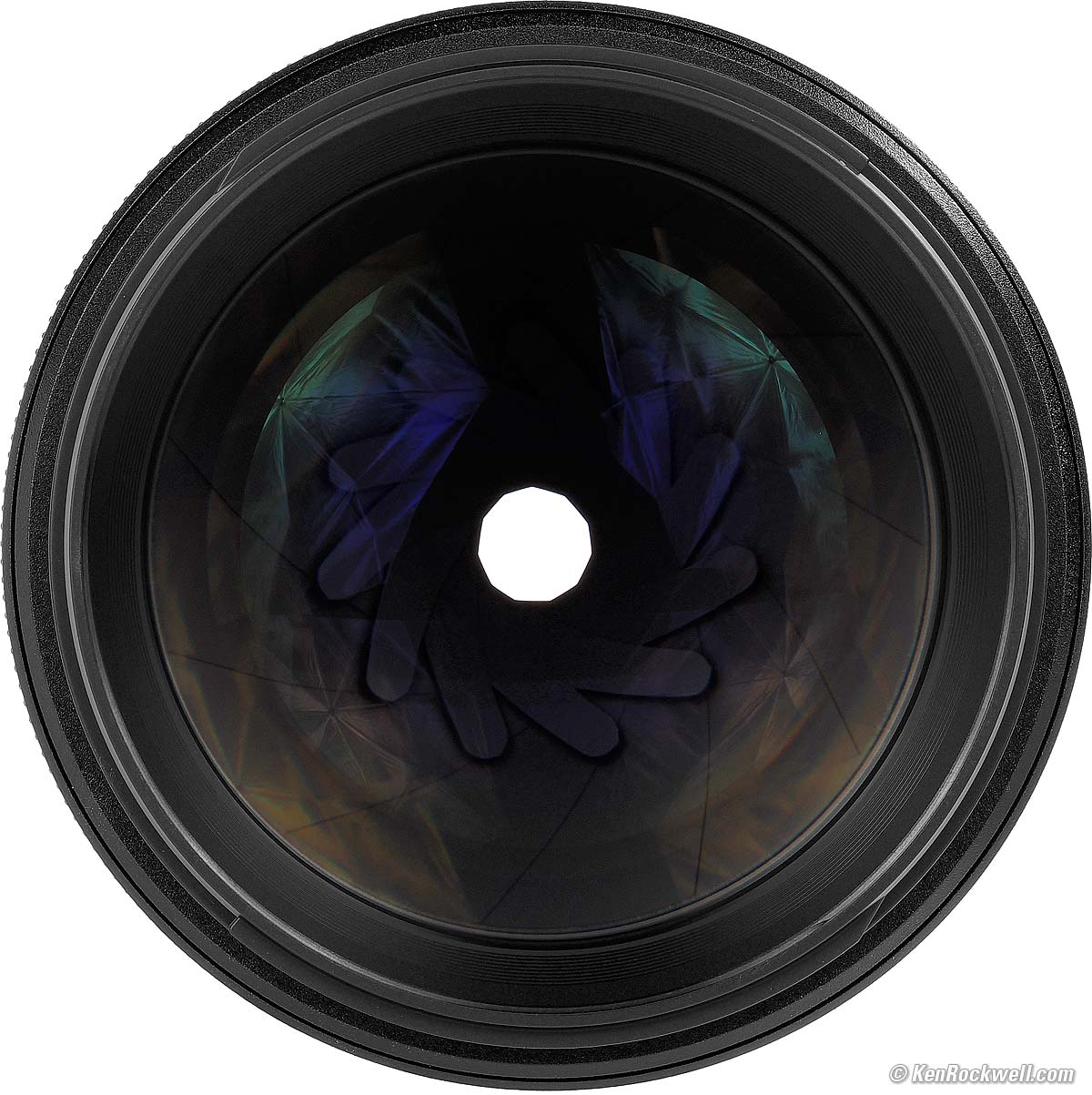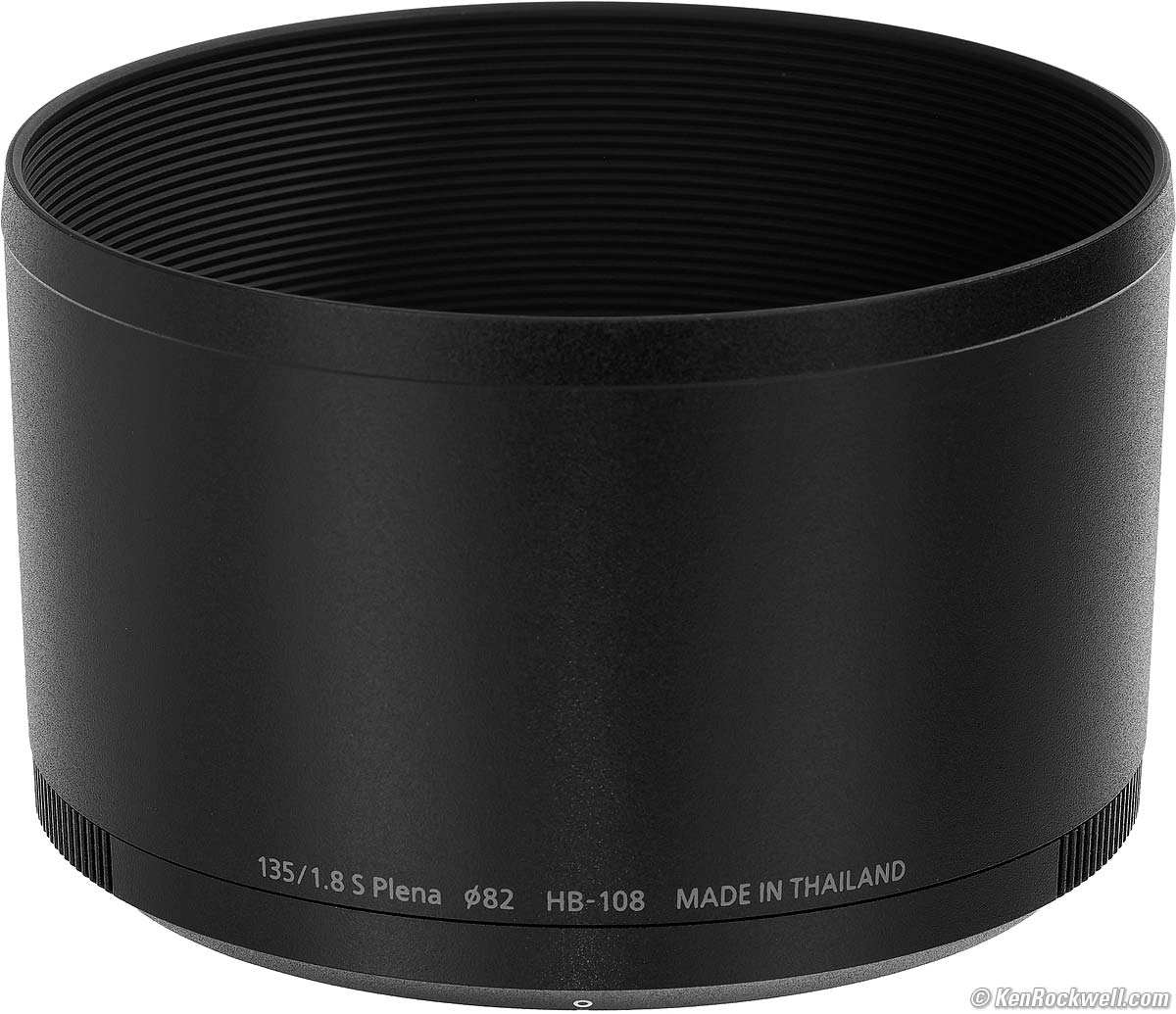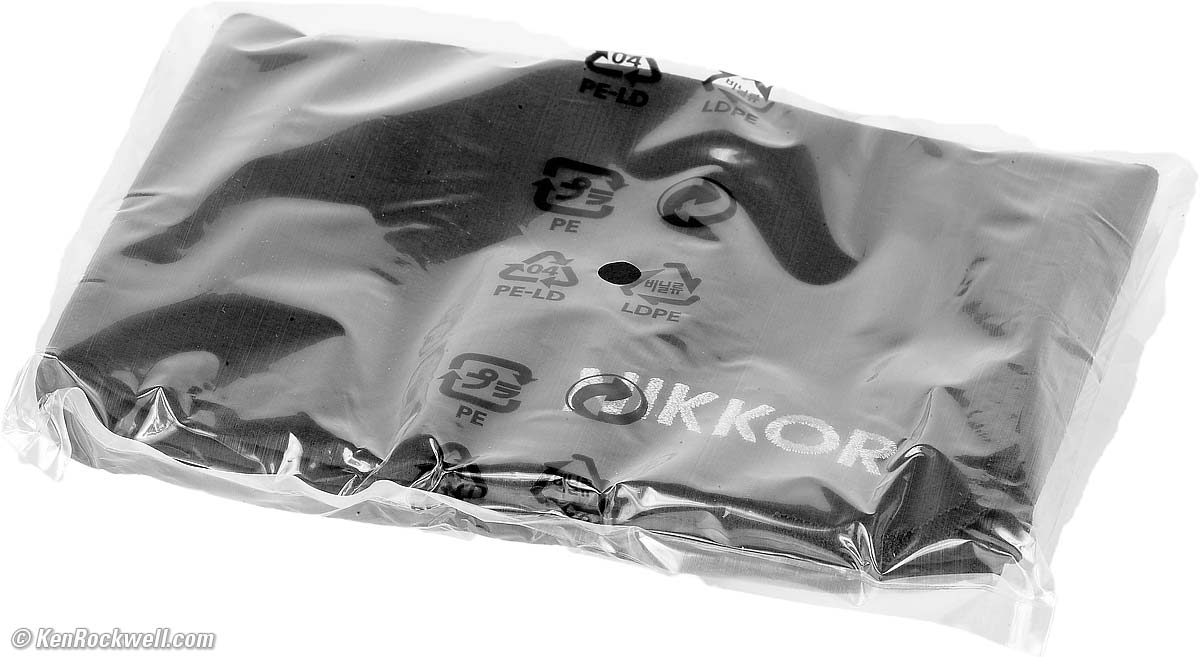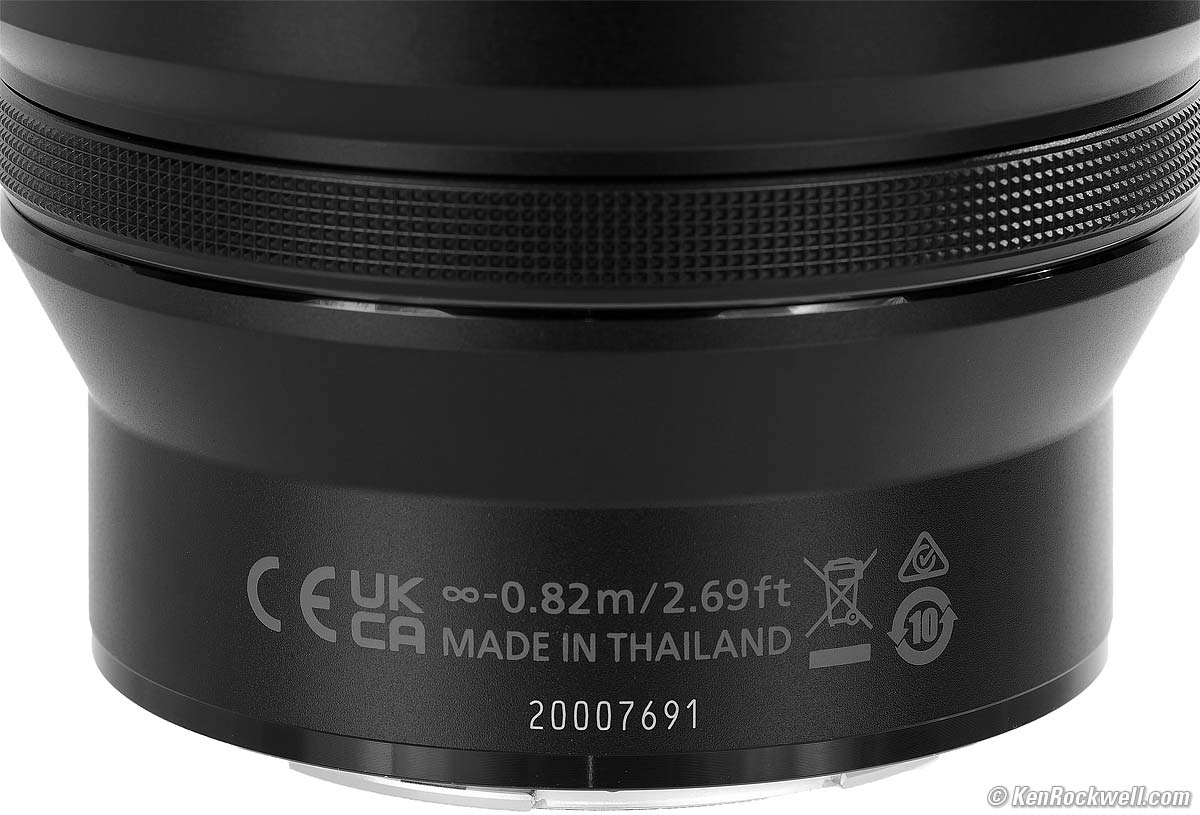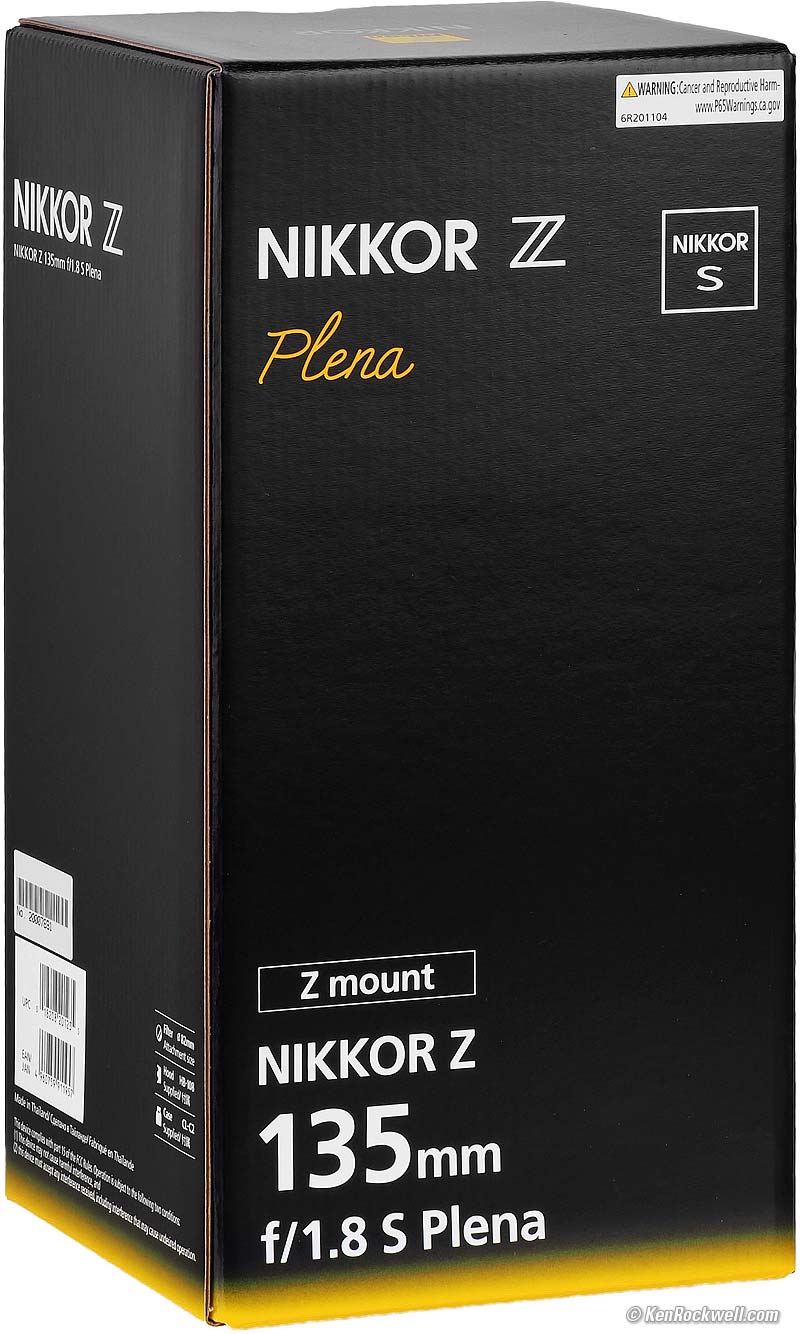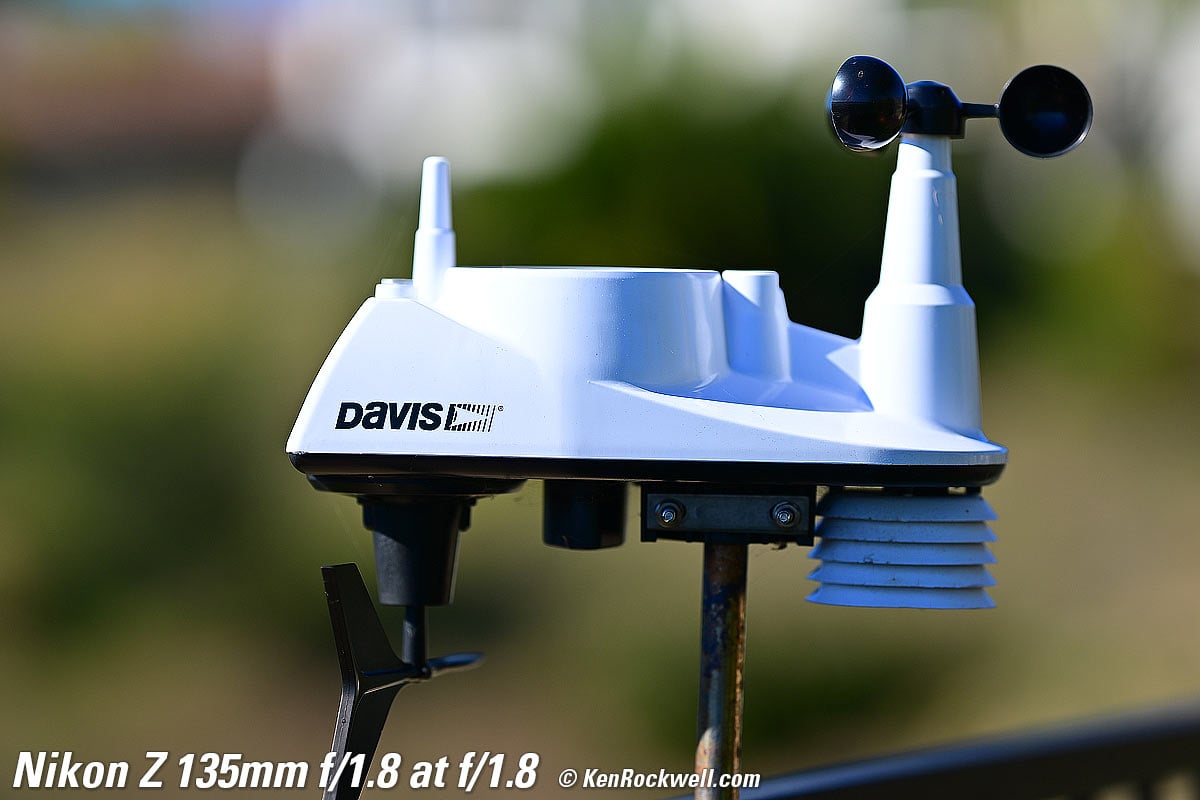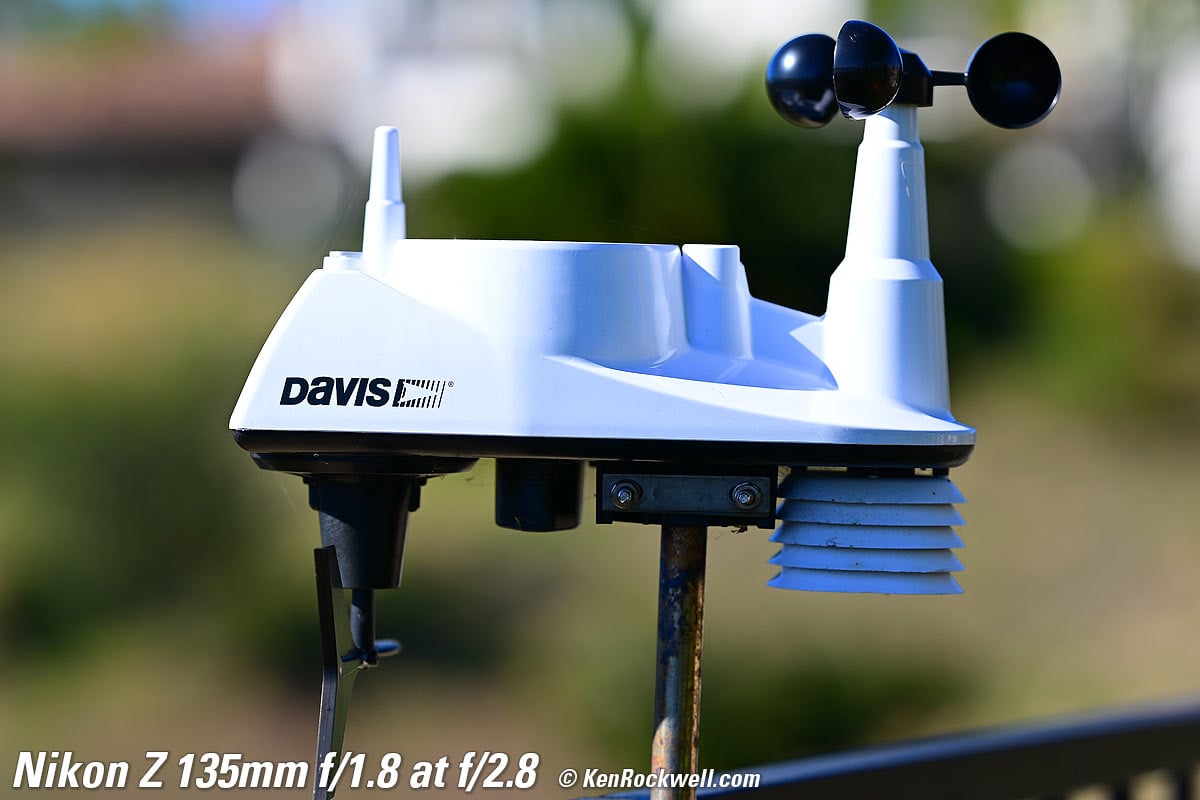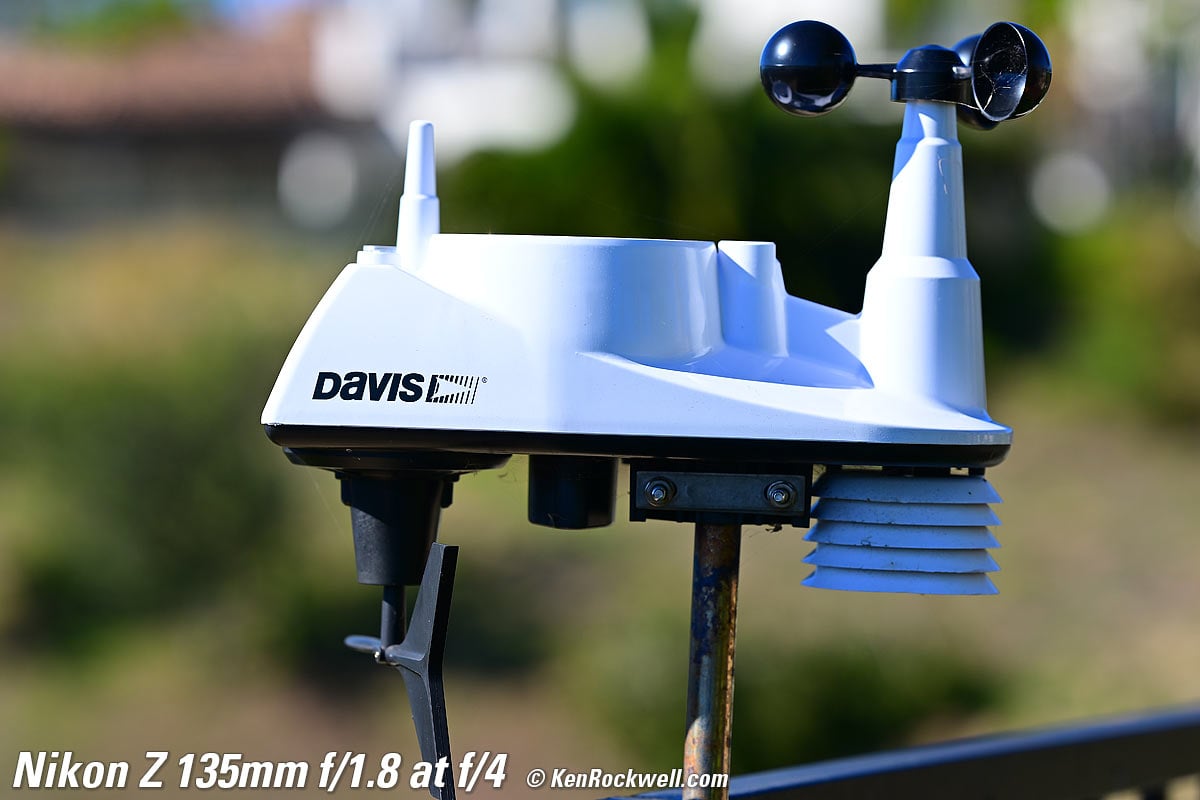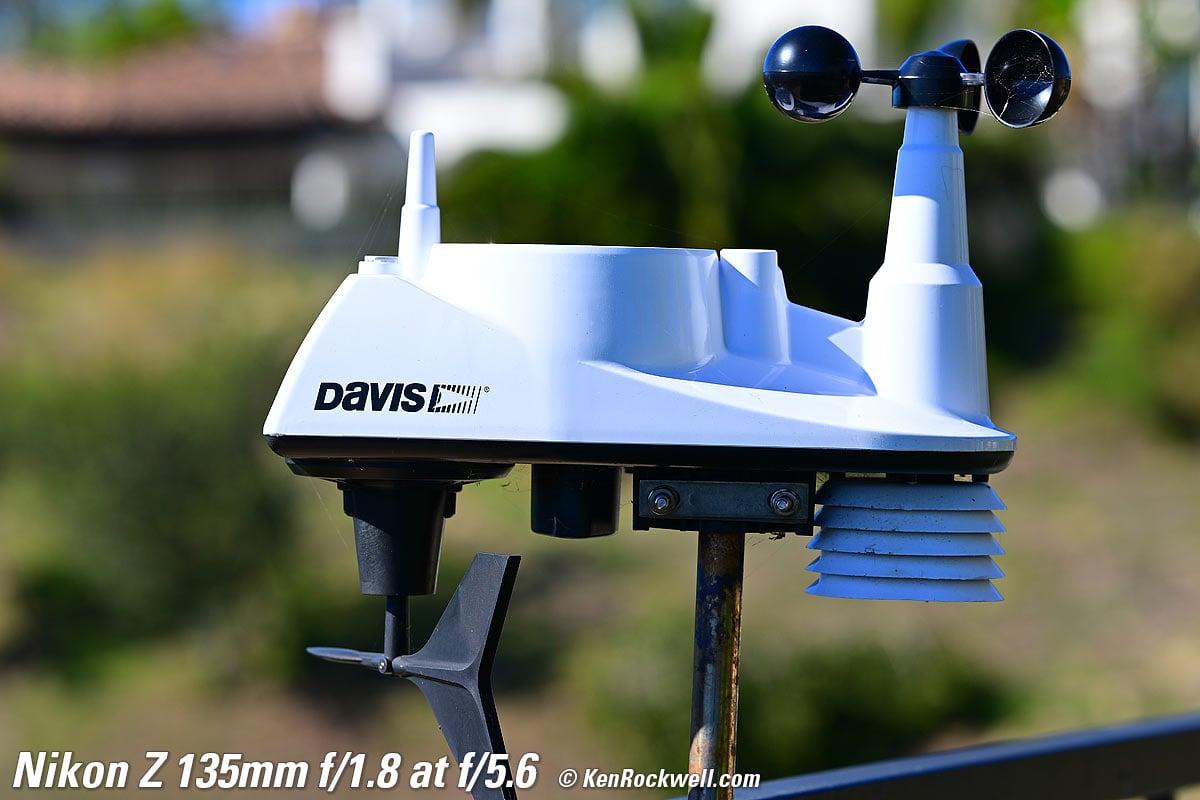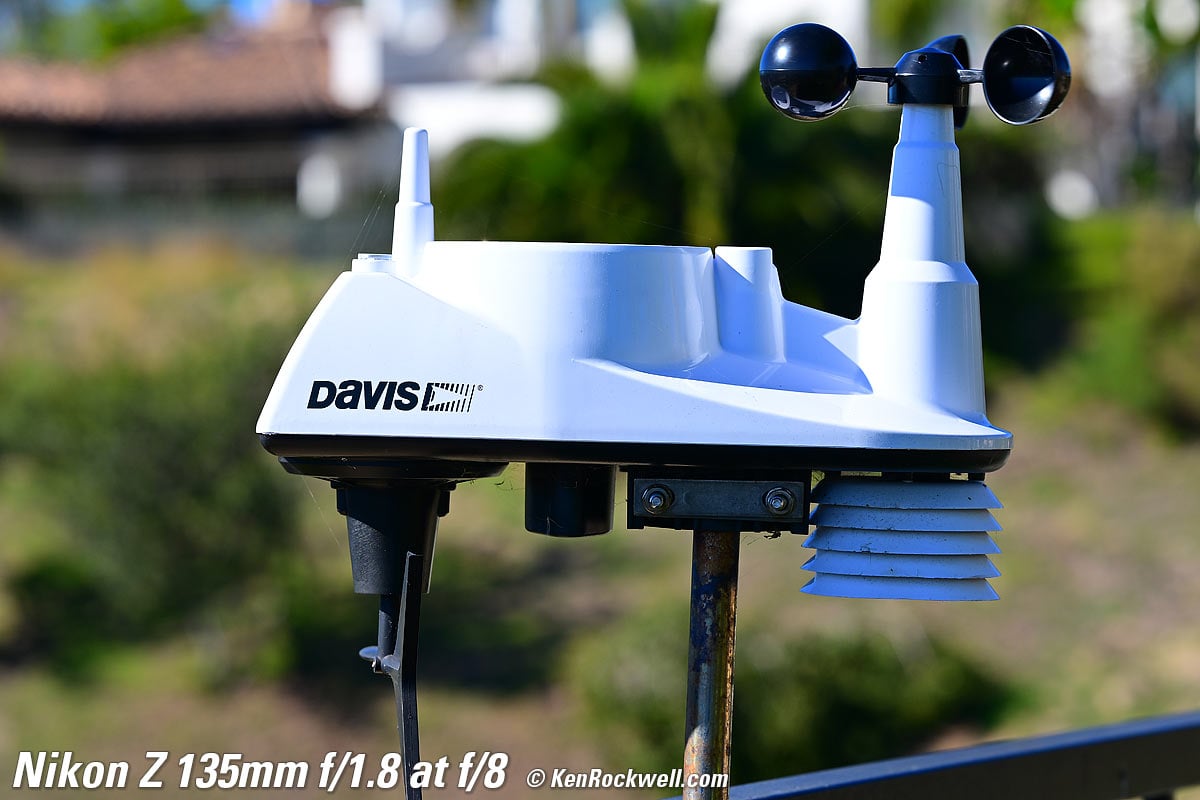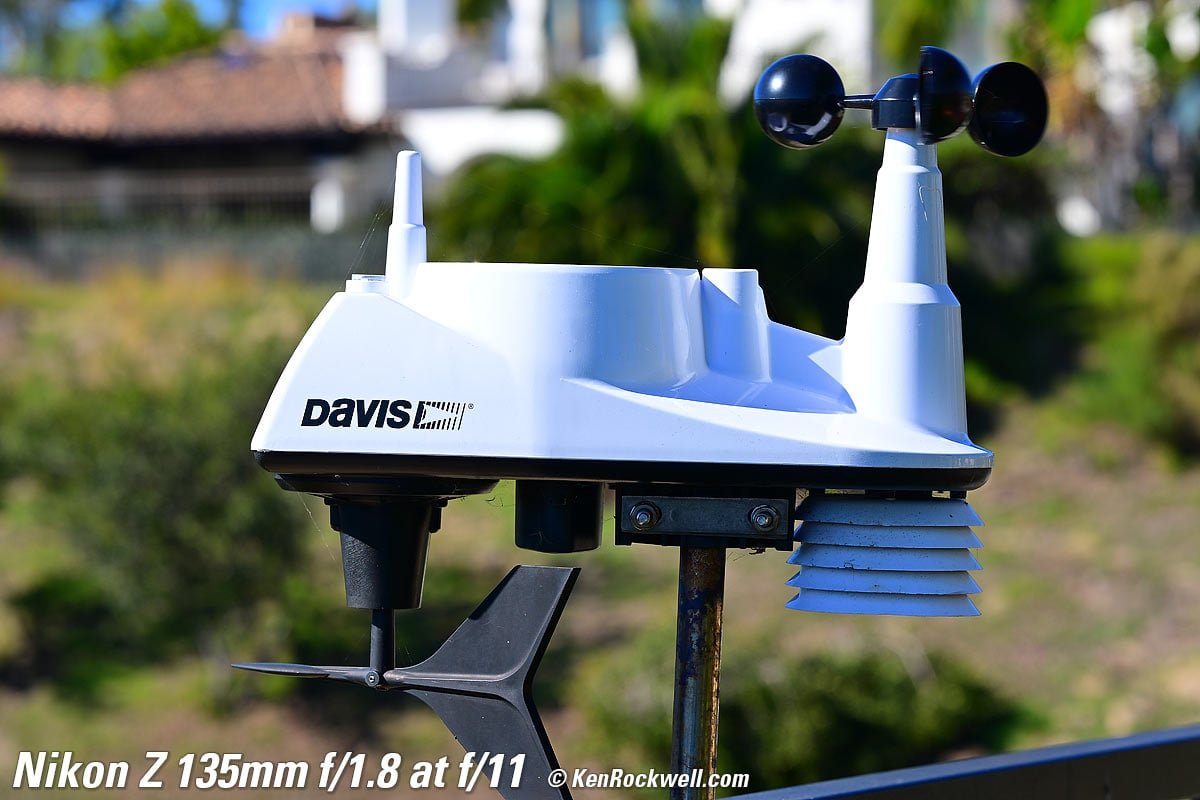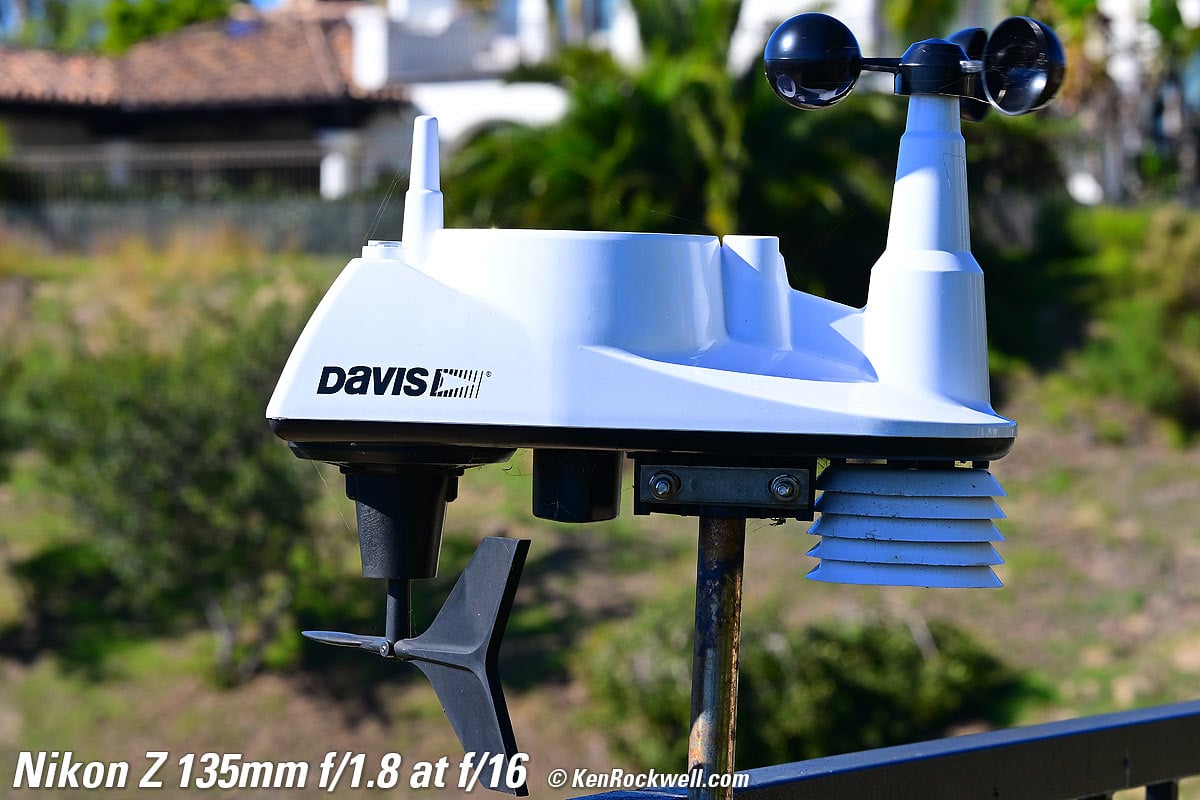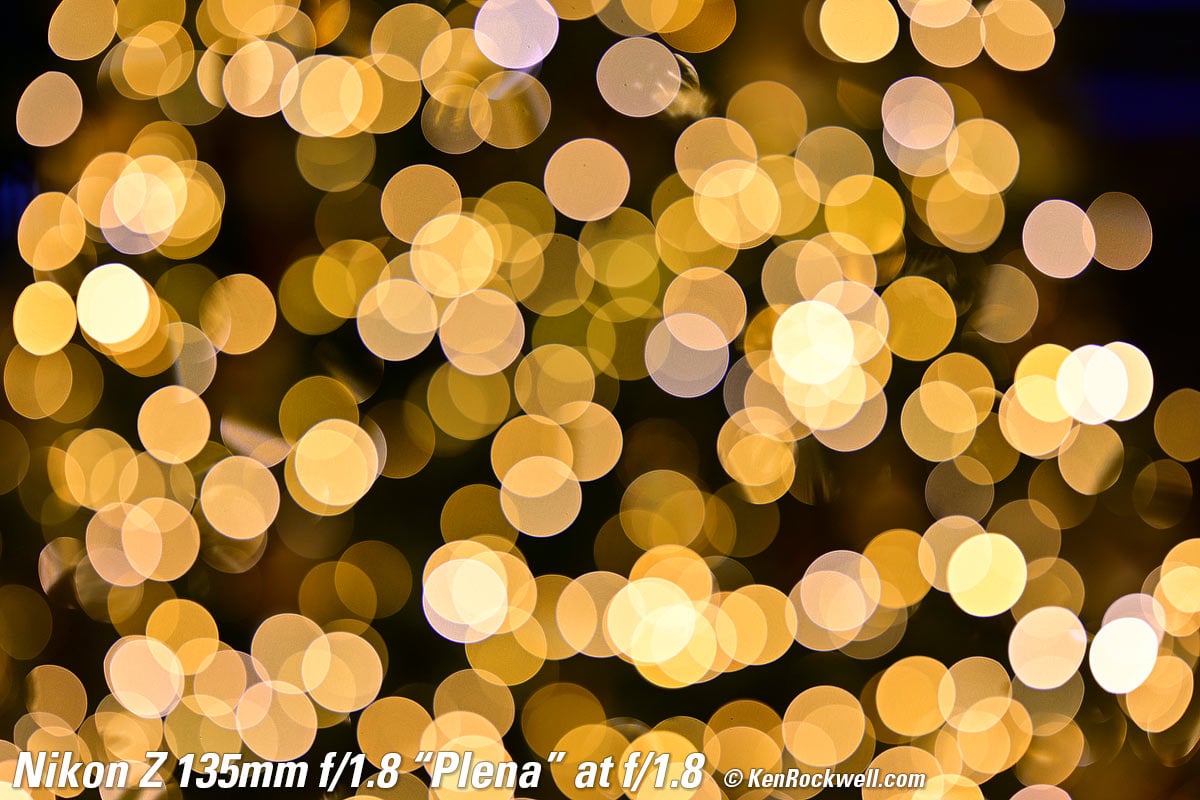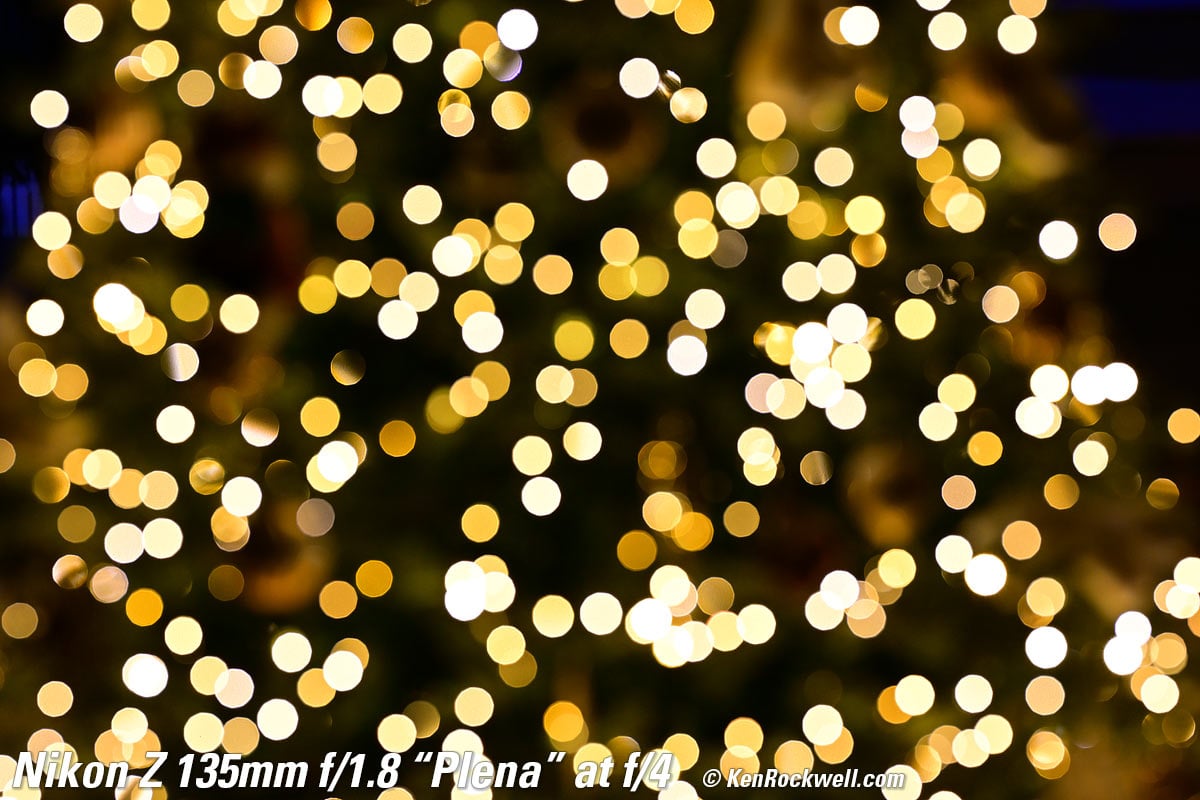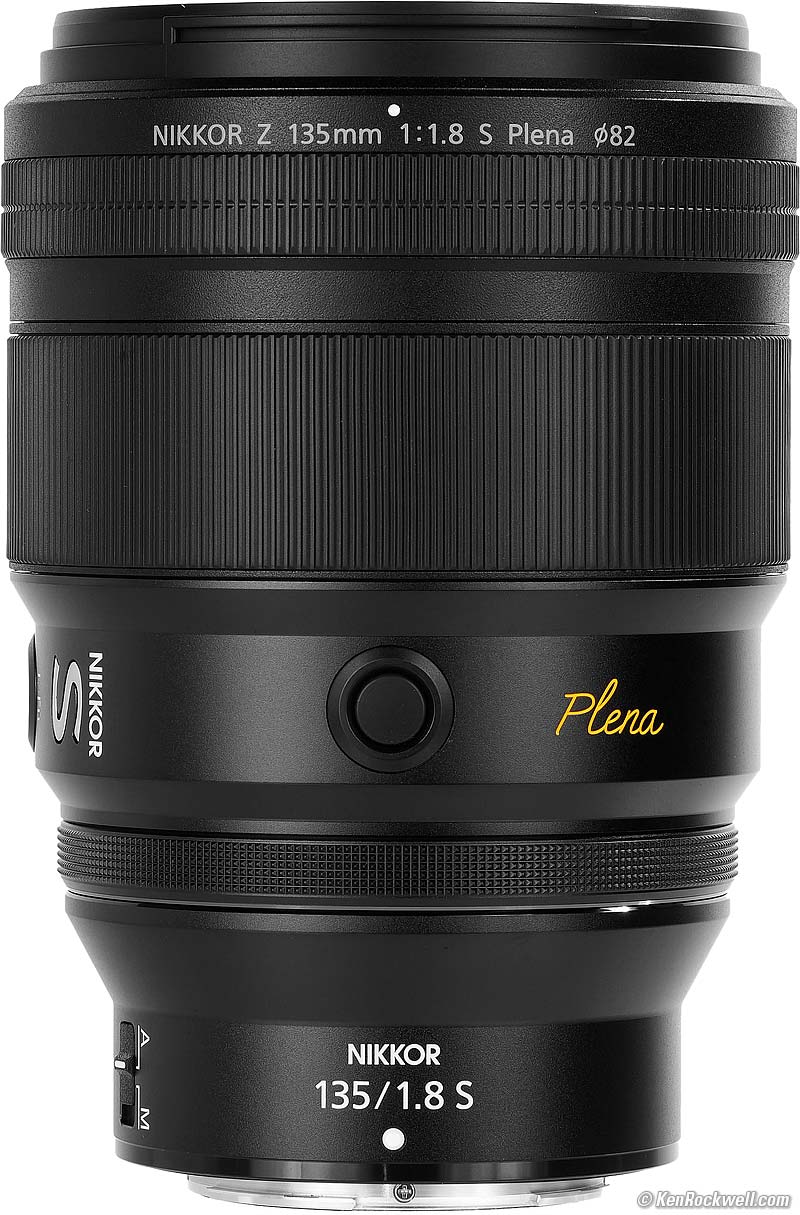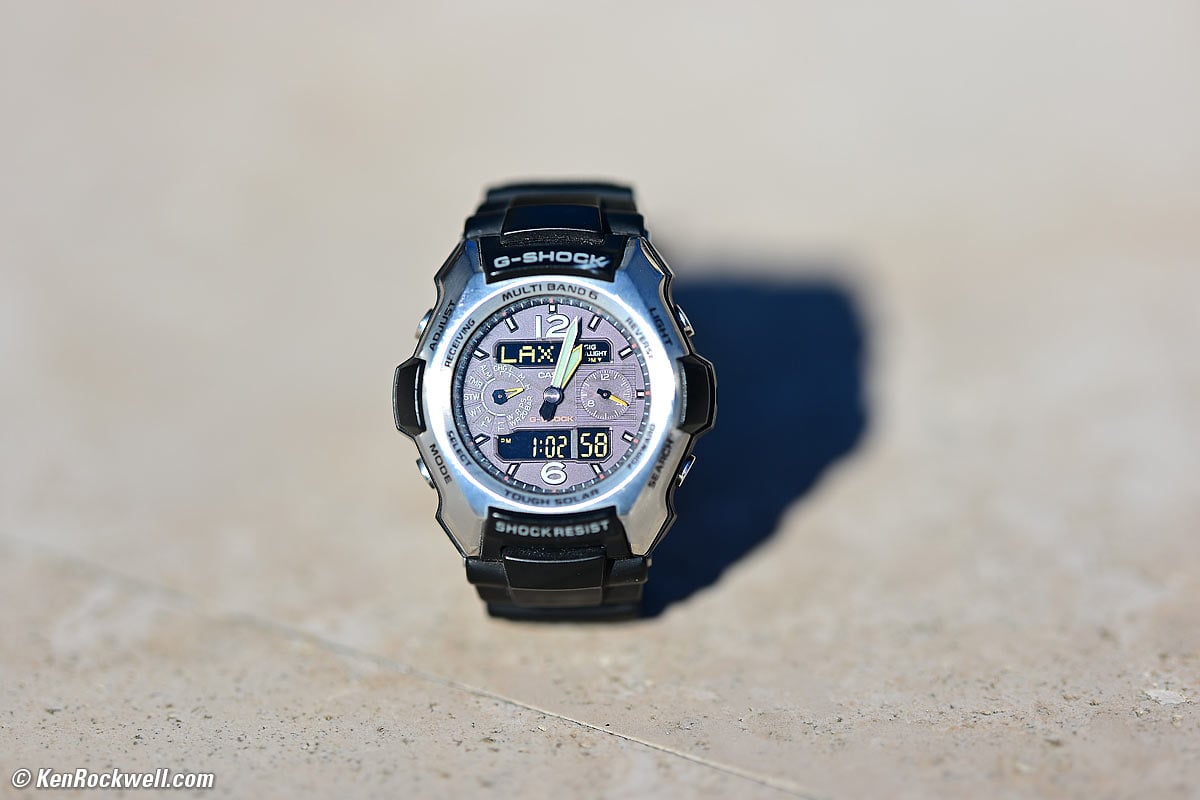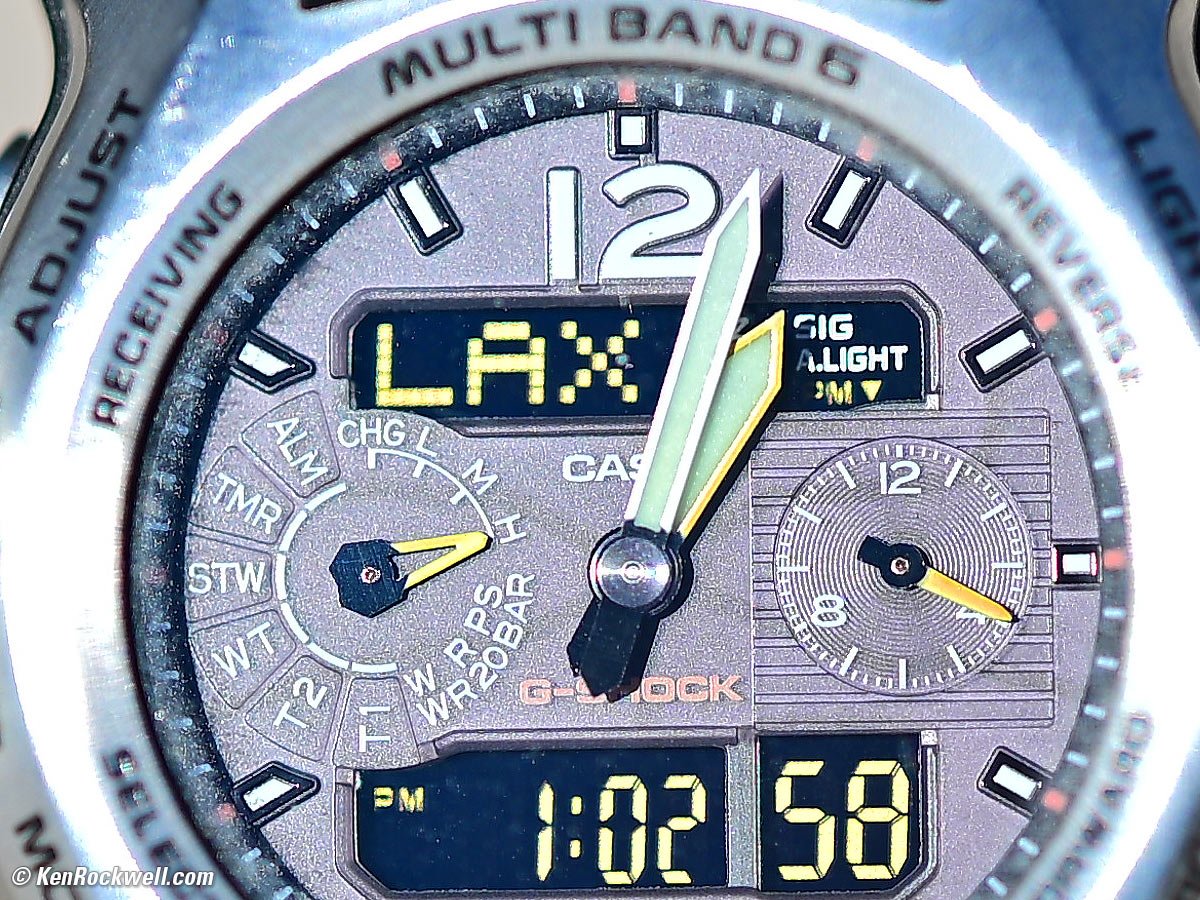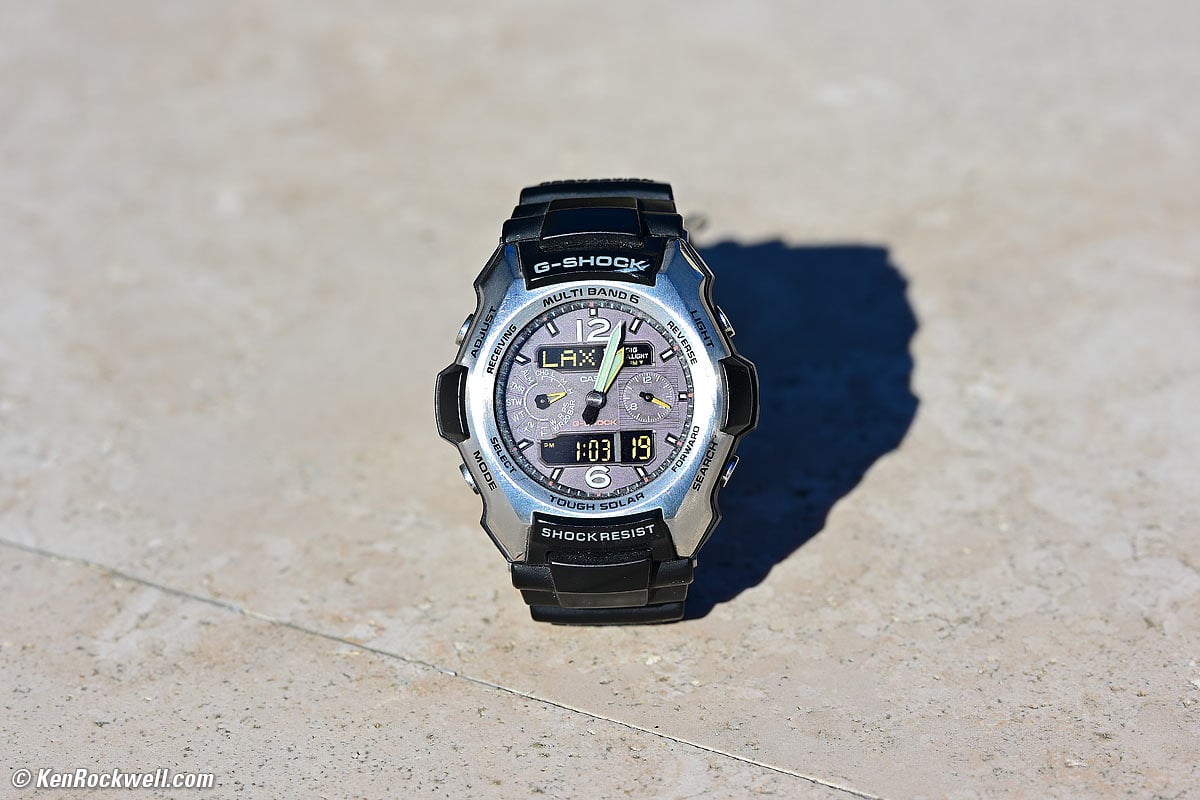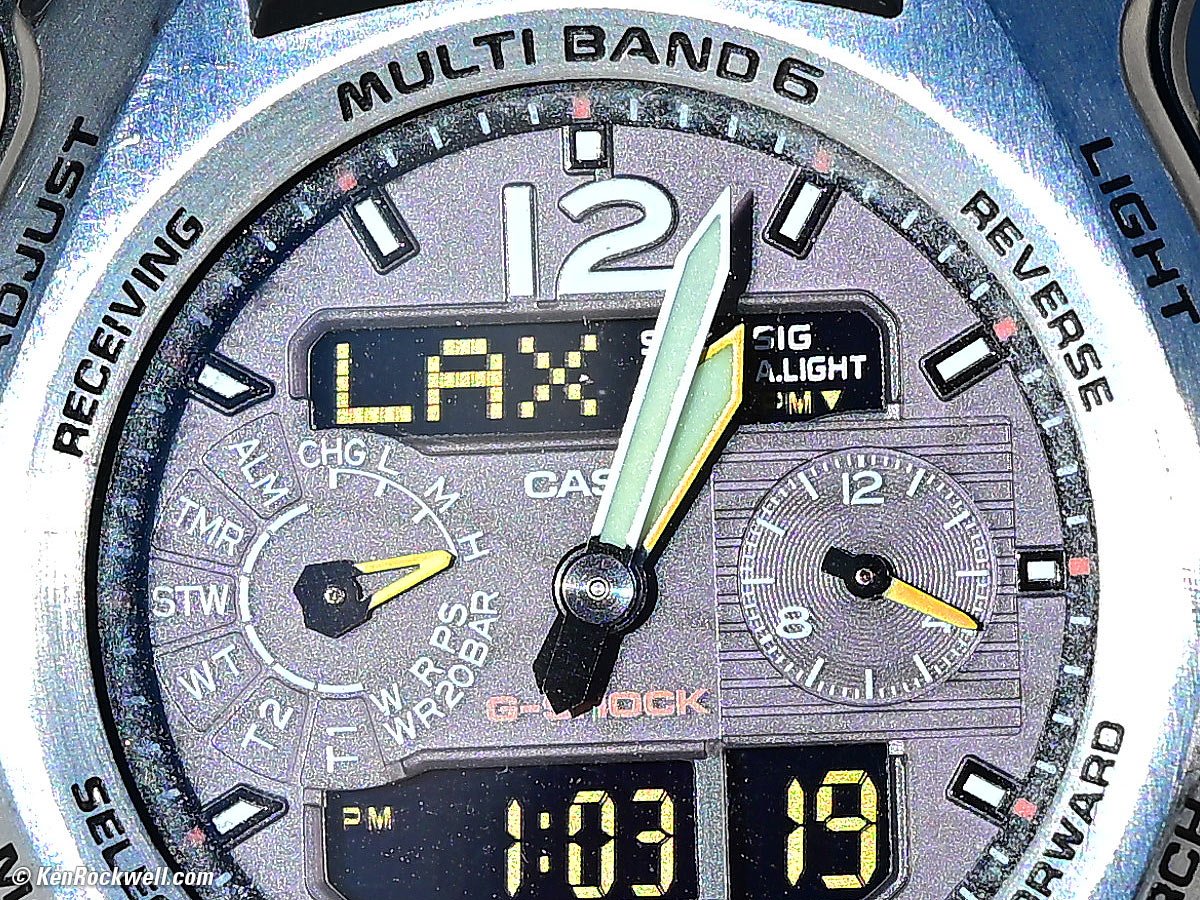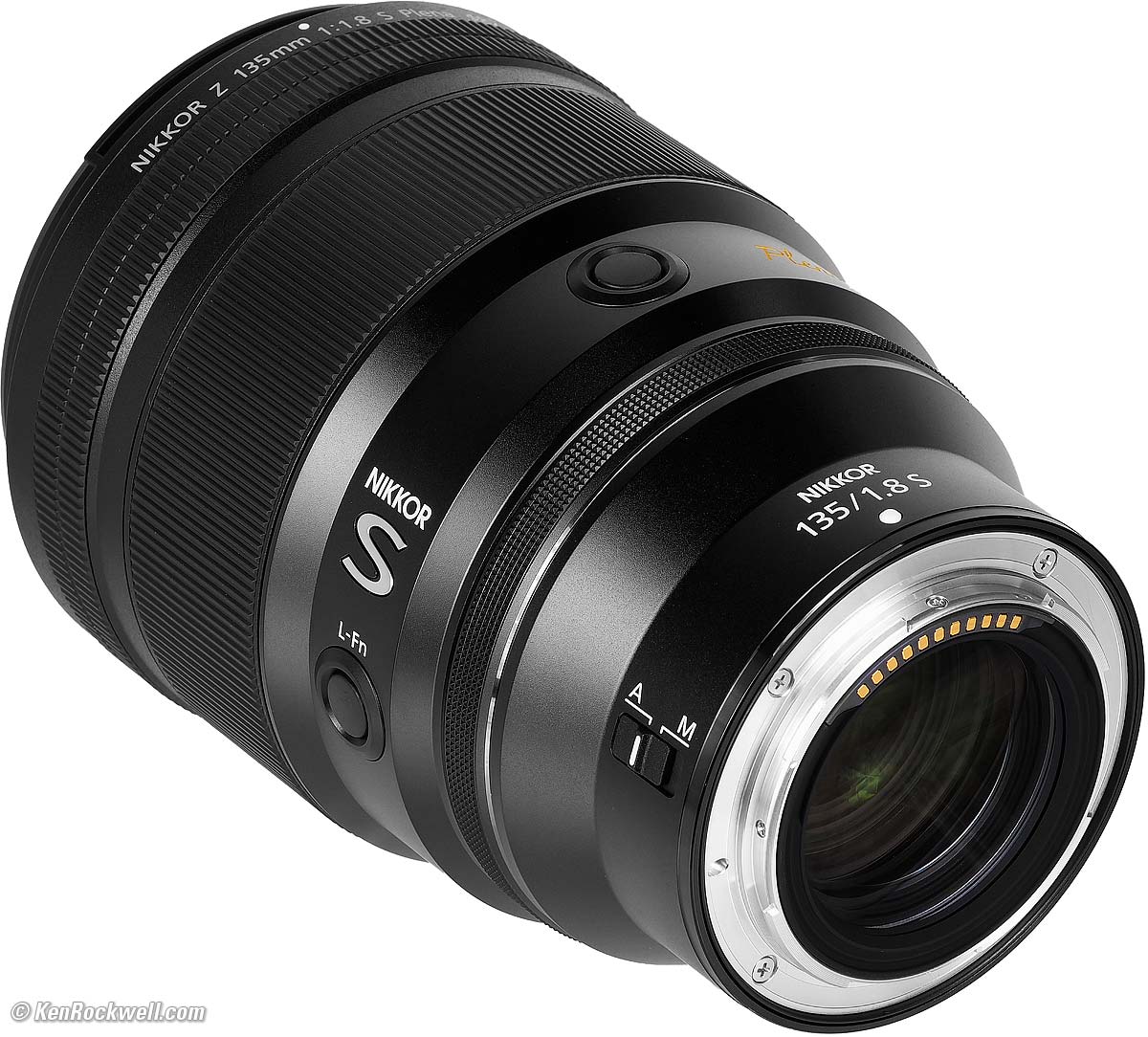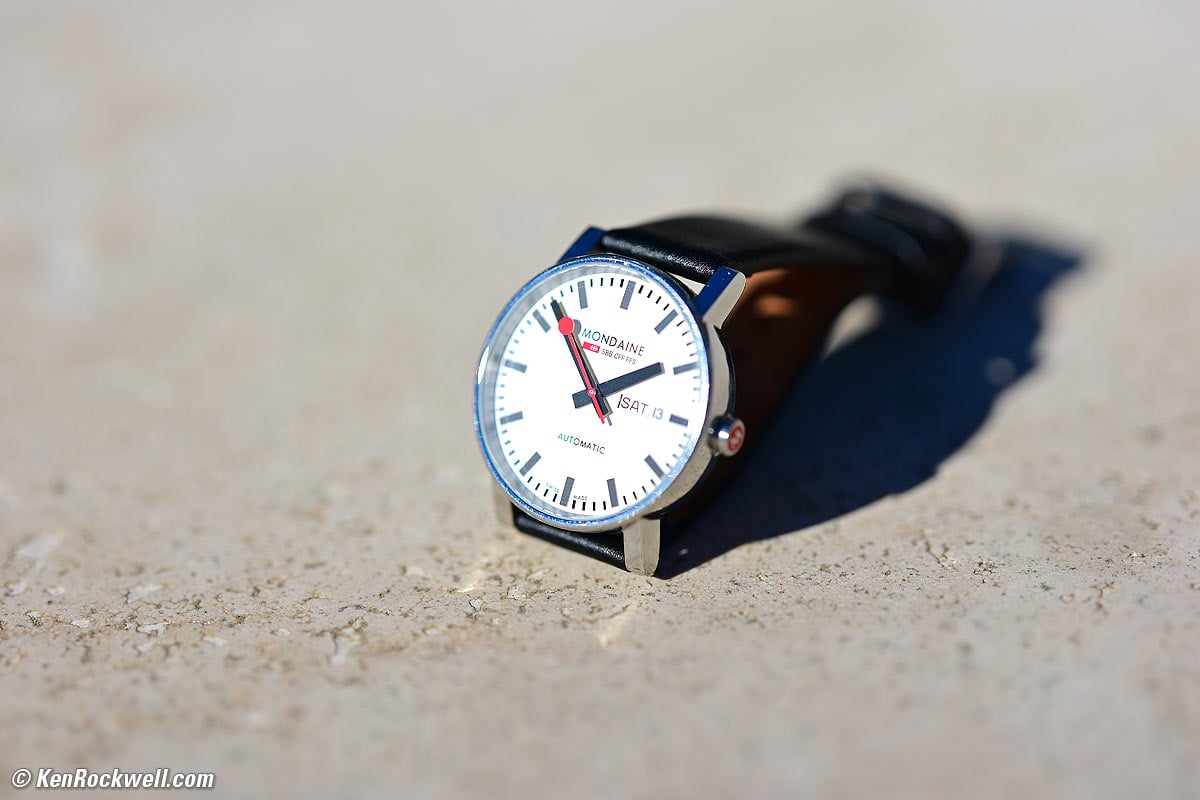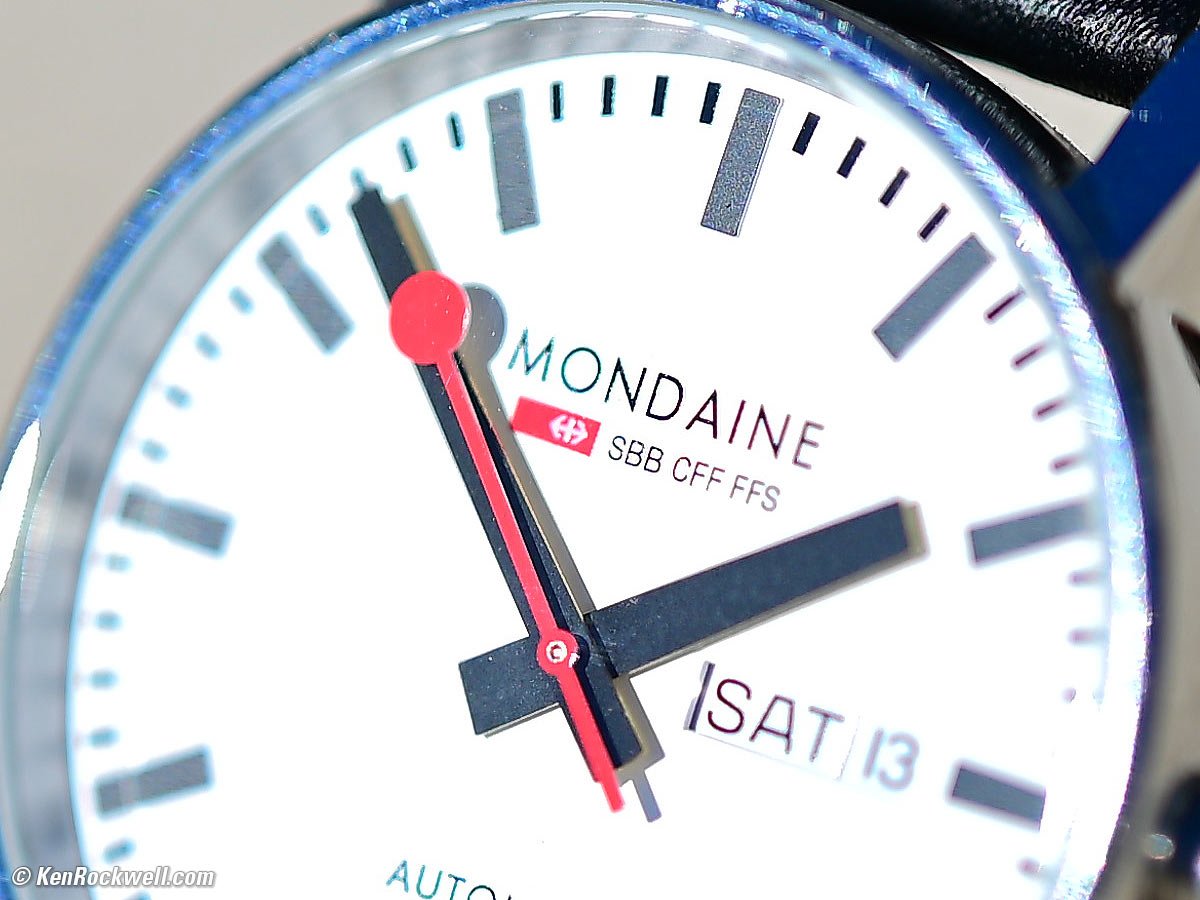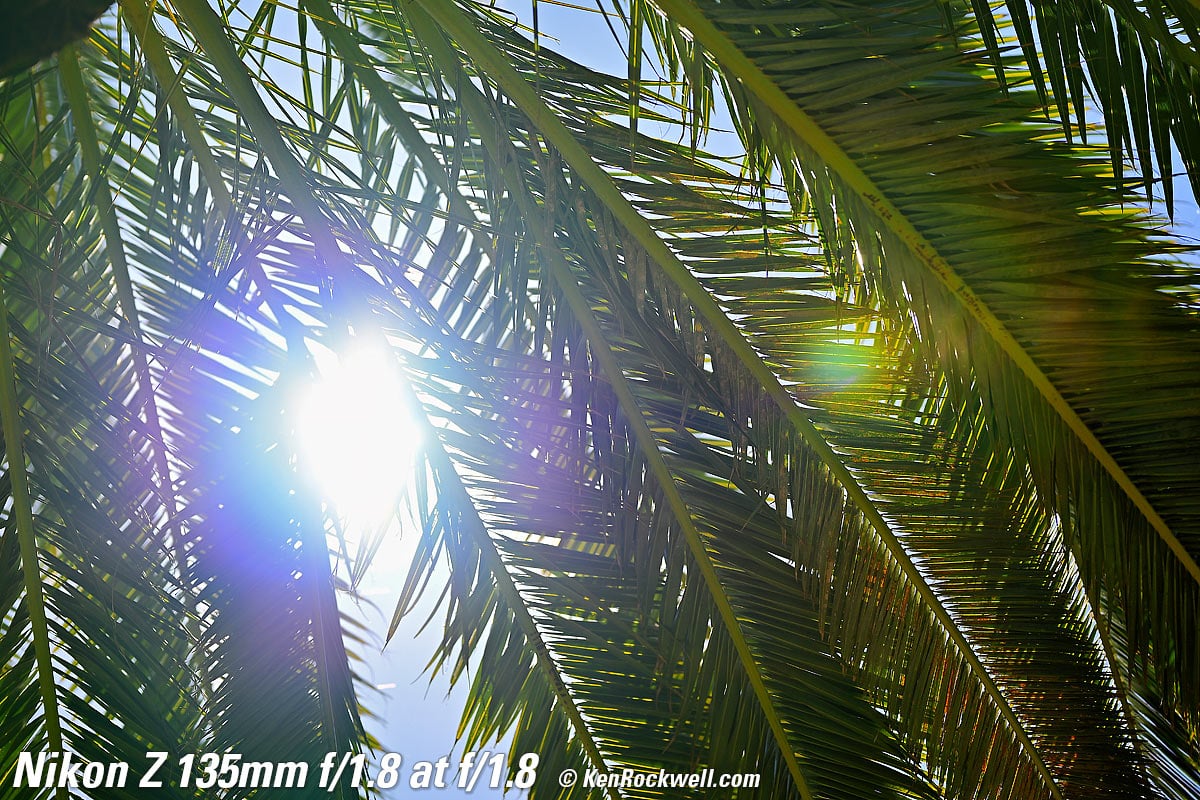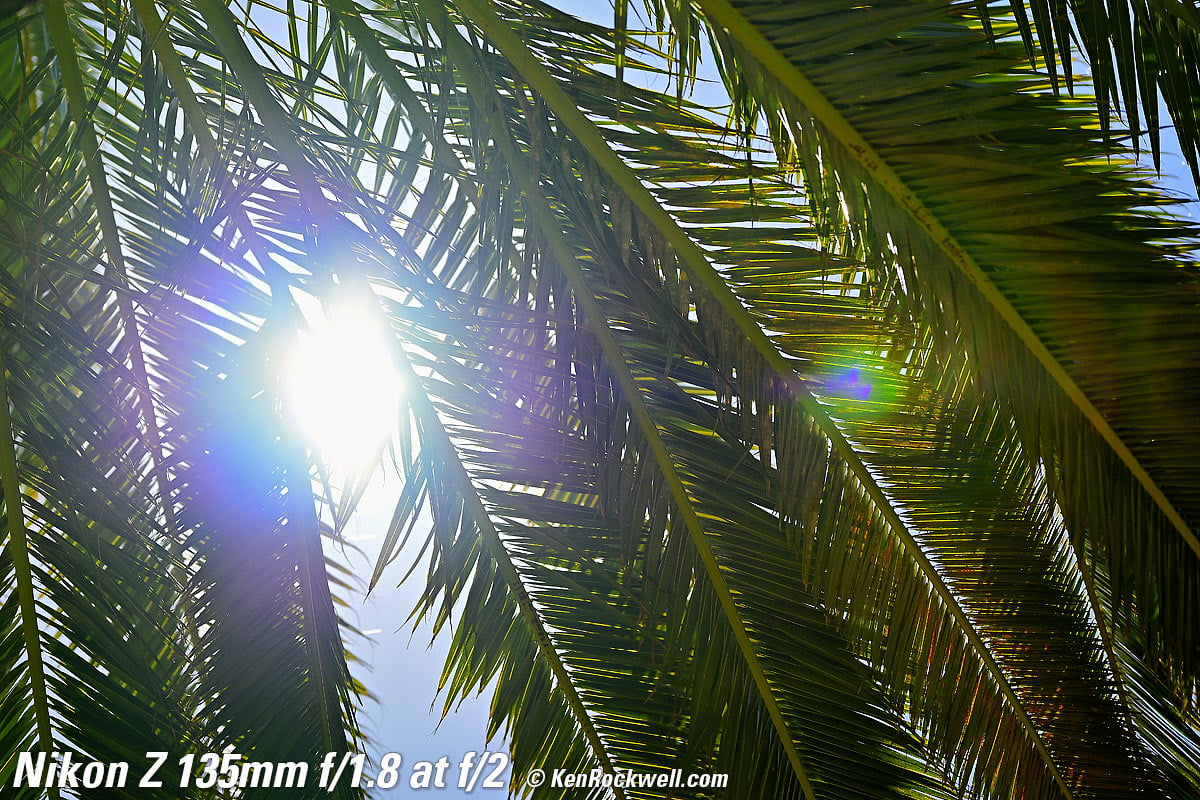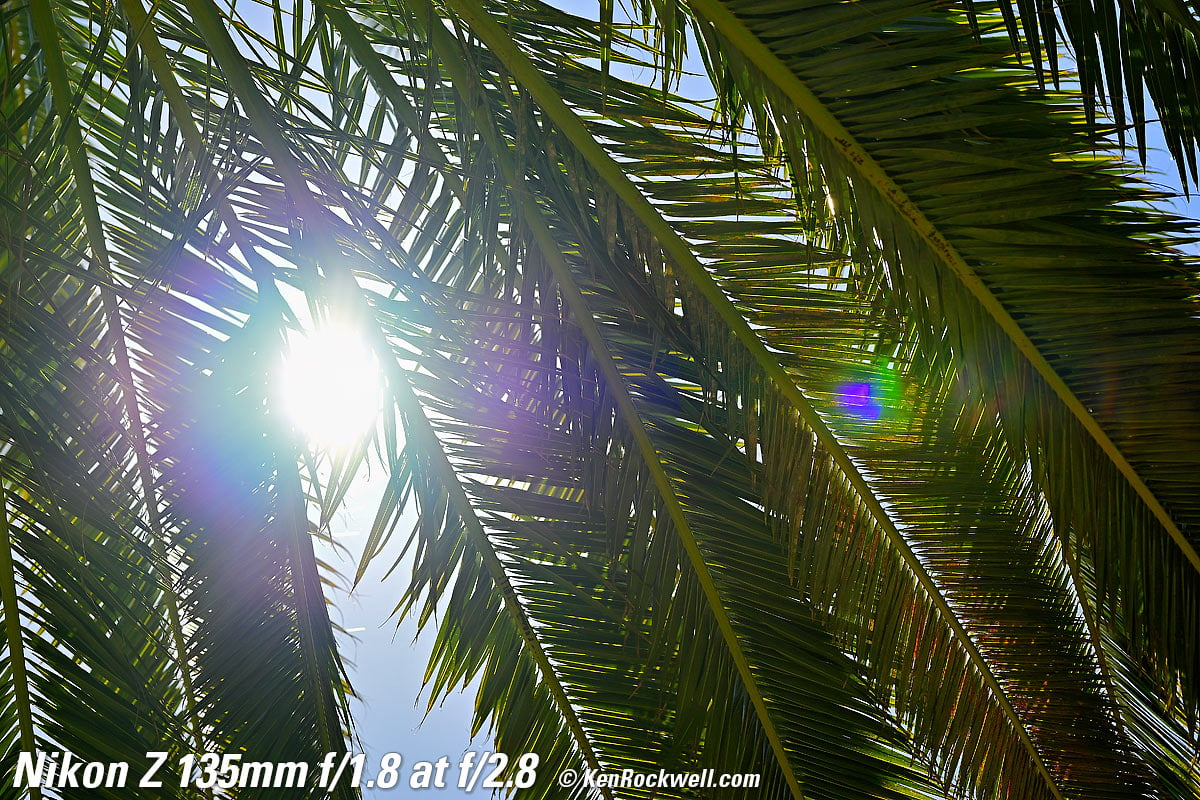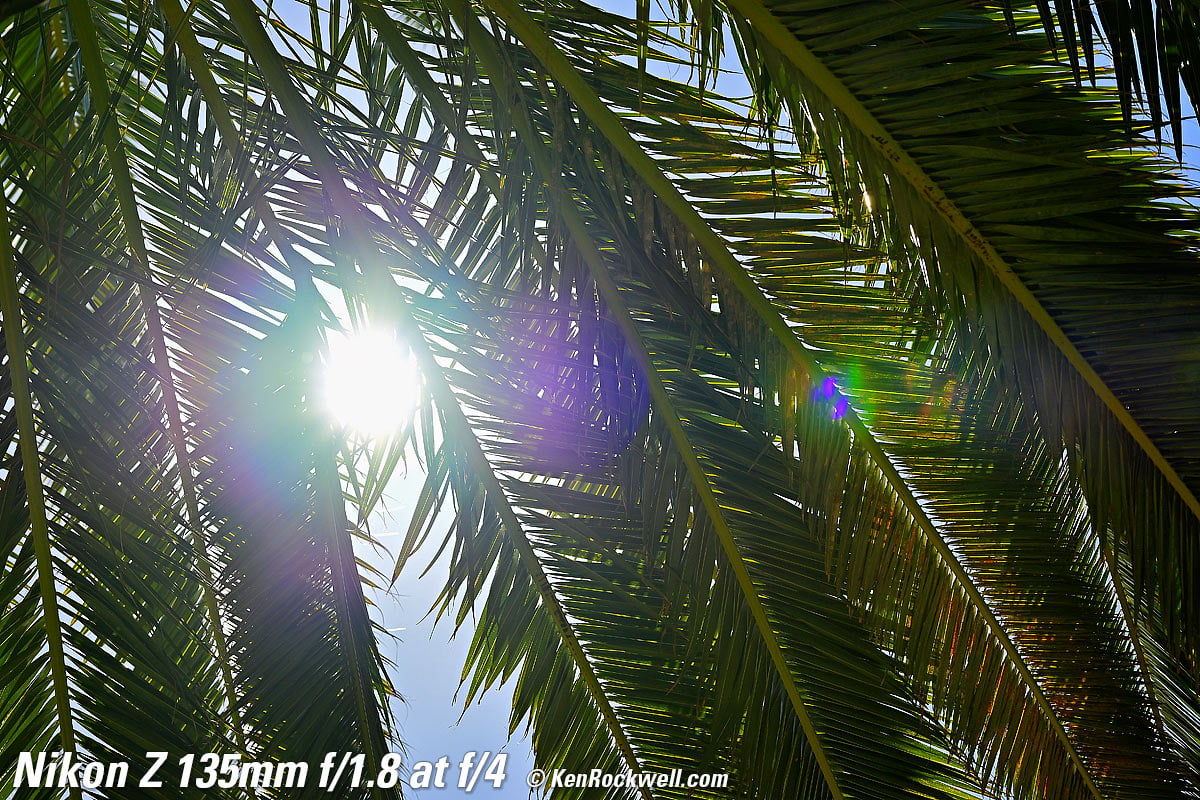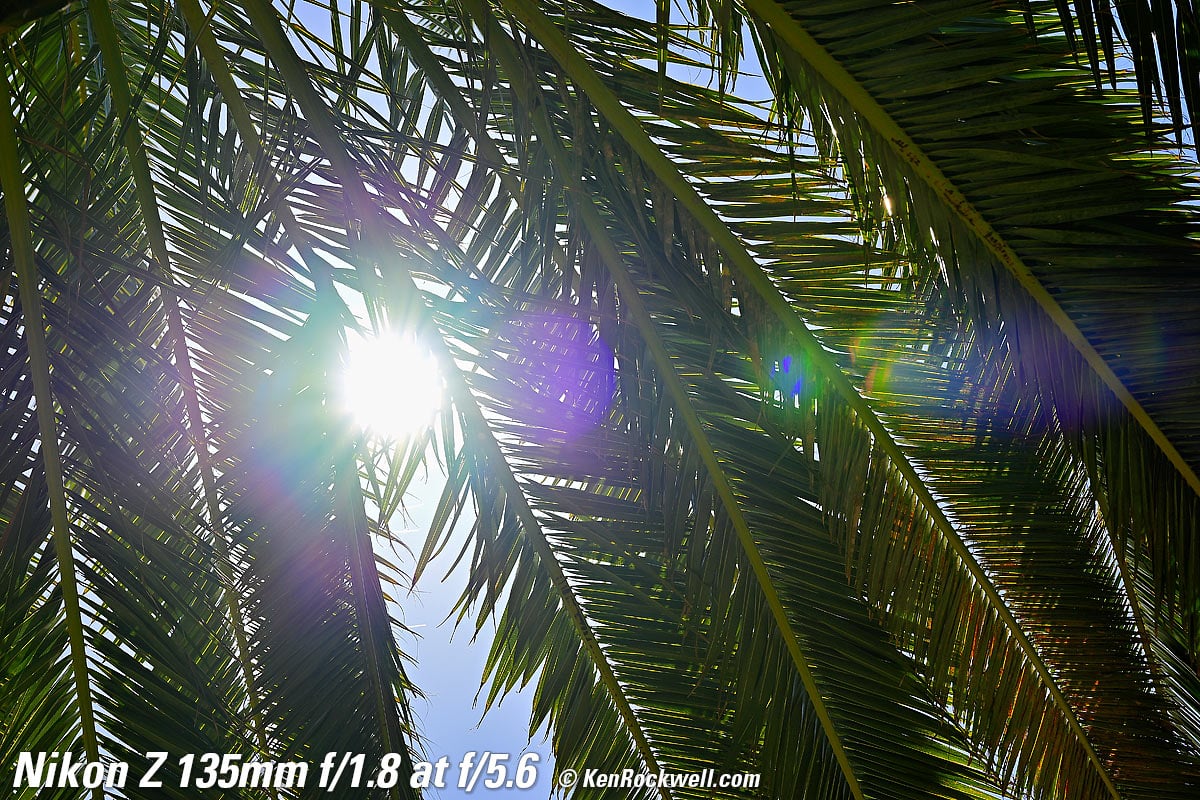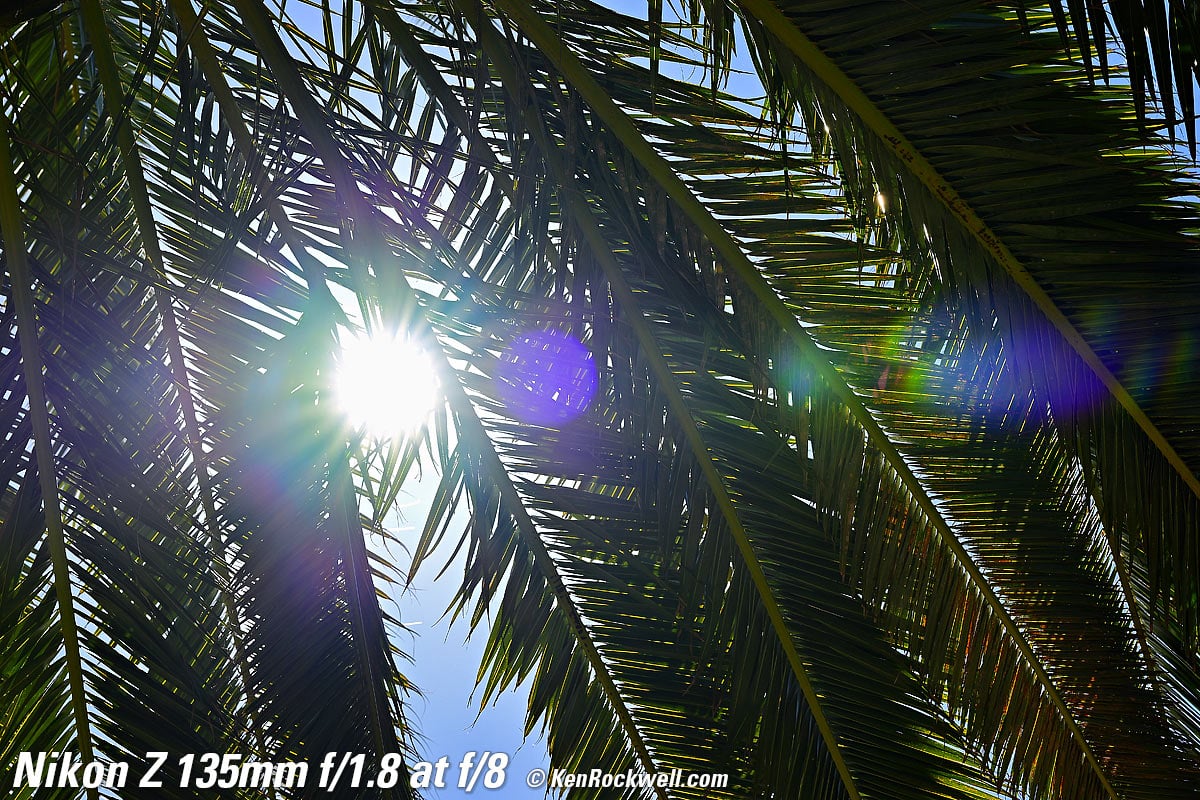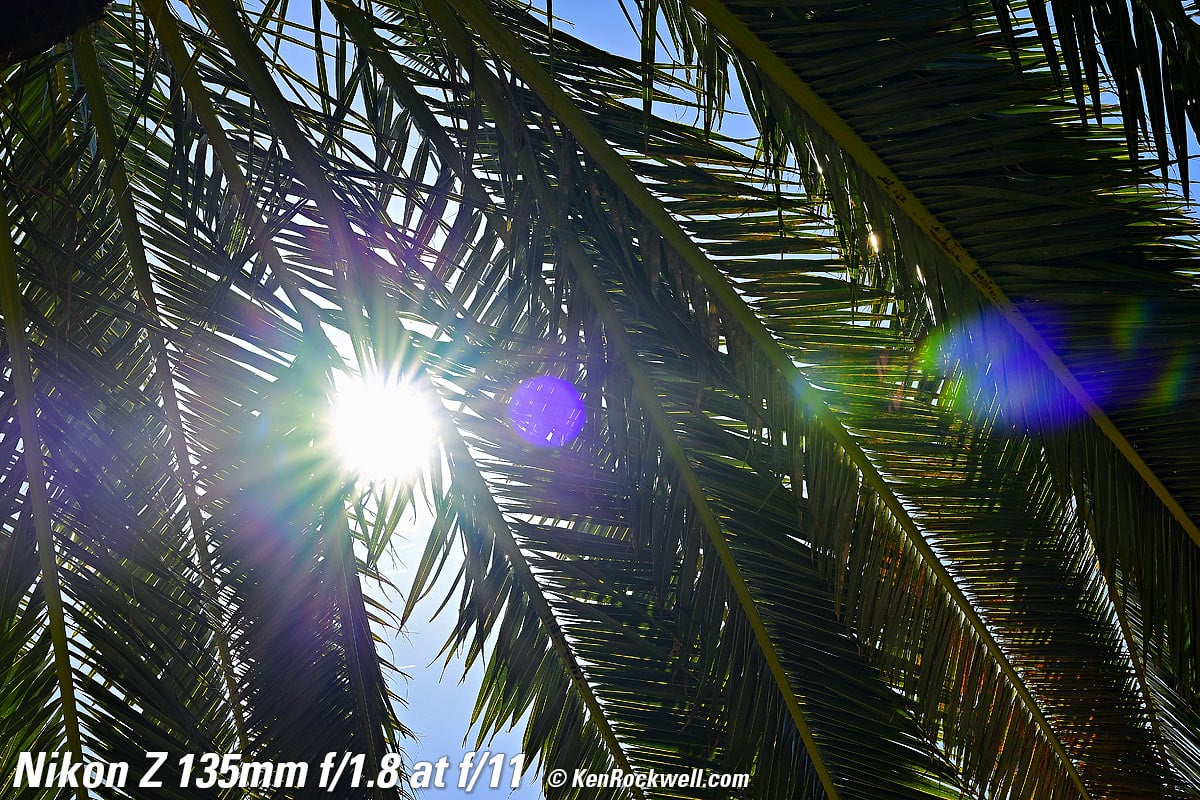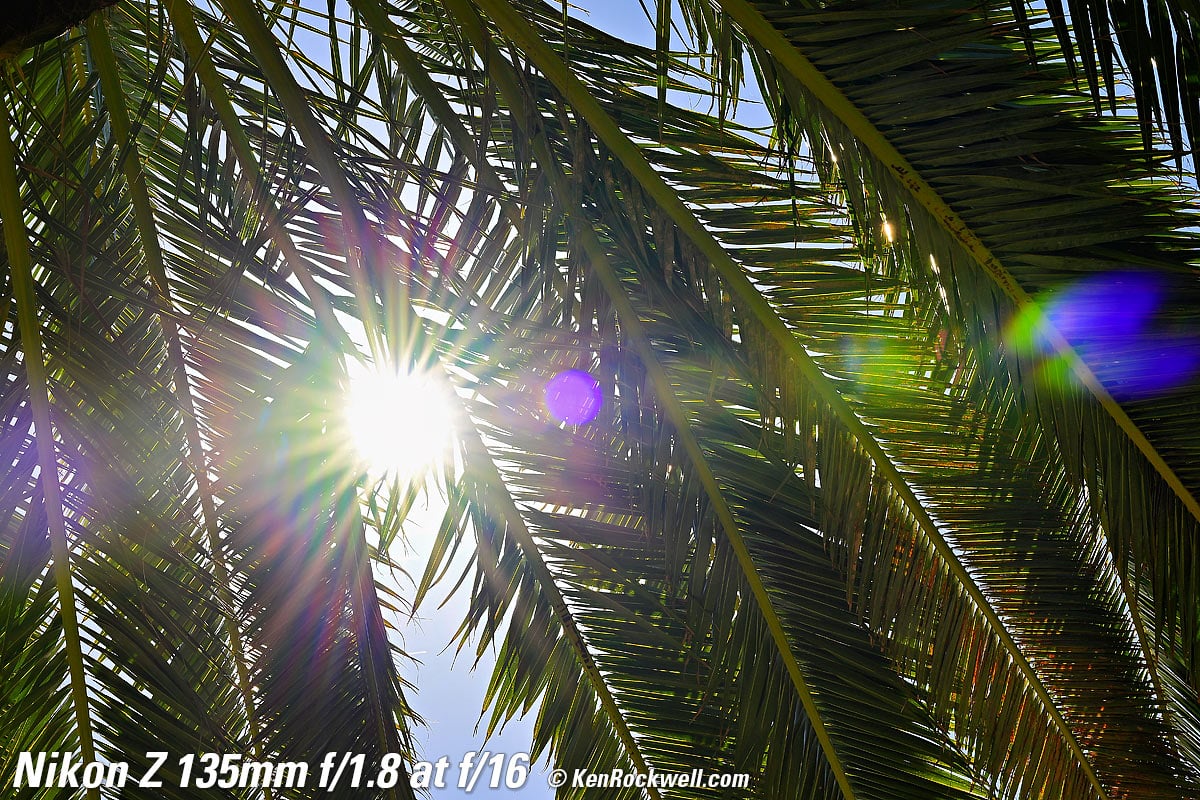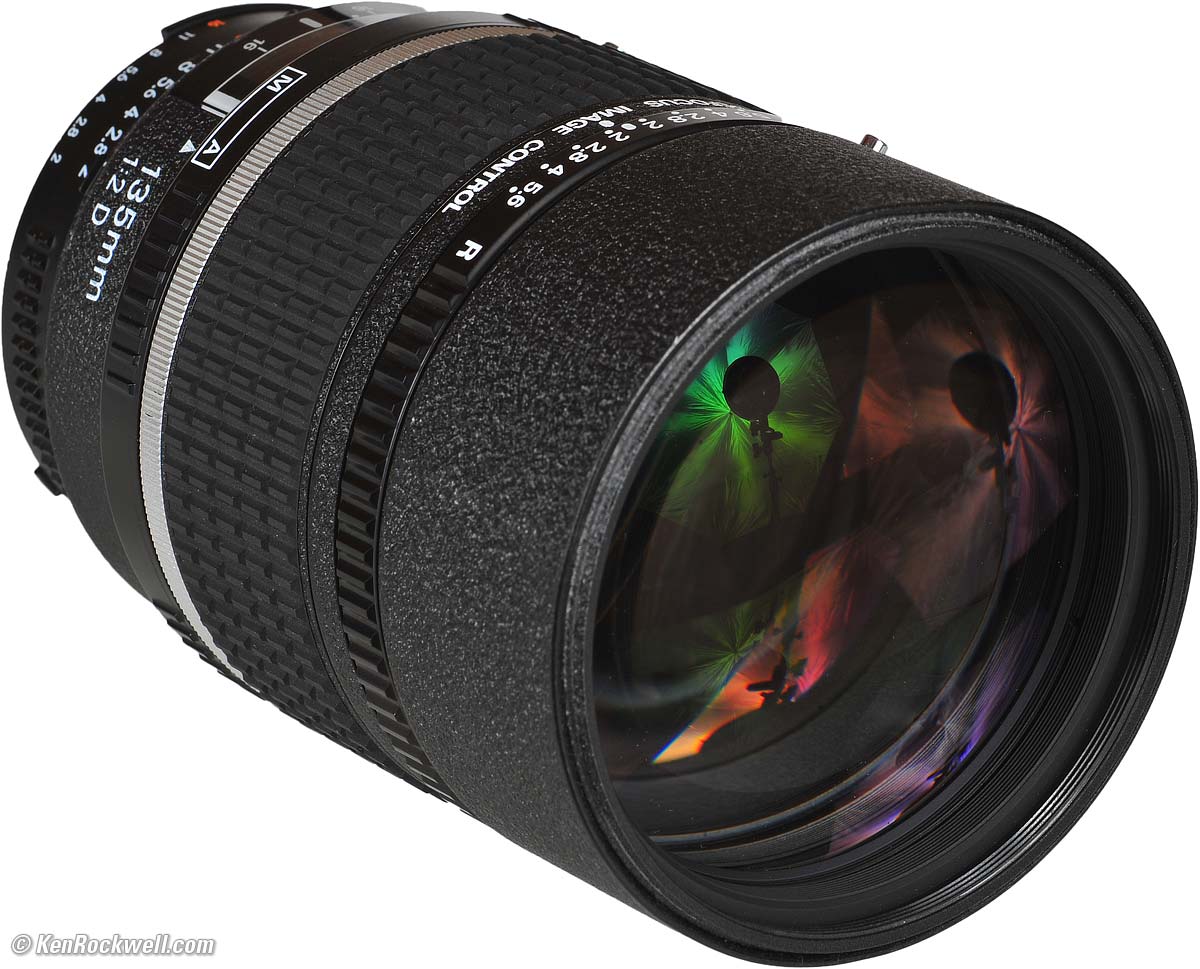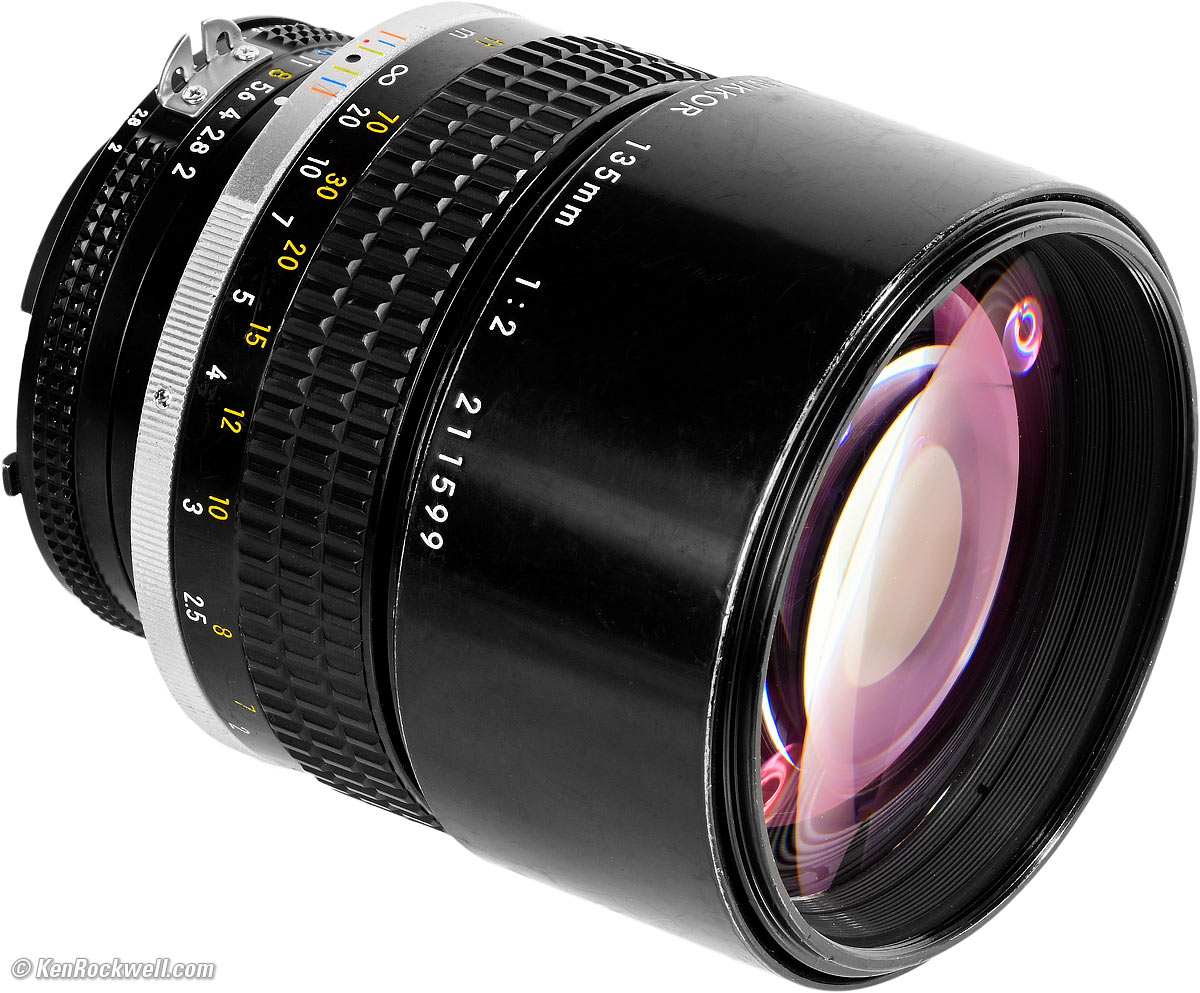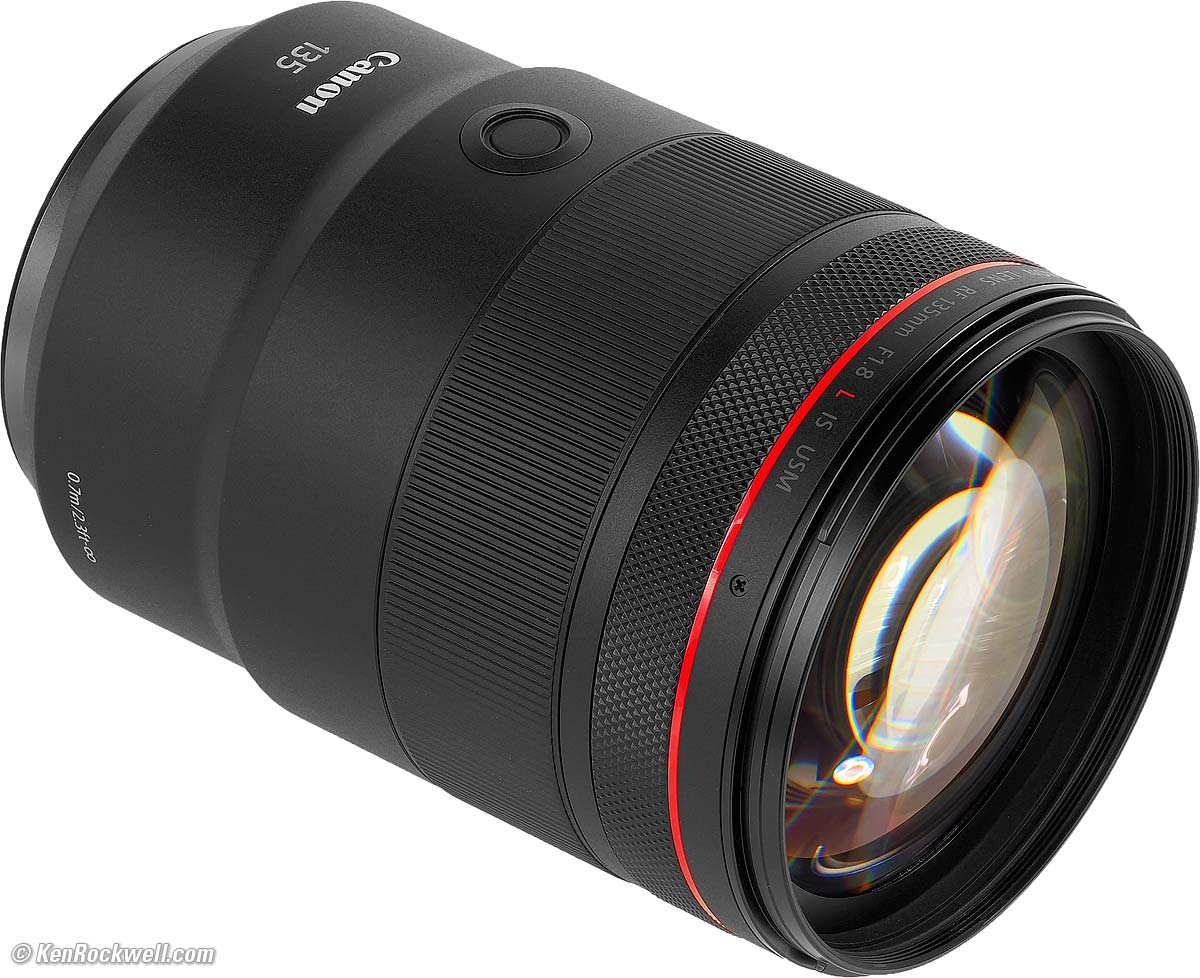Nikon Z 135mm f/1.8
Full Frame "Plena" (2023-)
Sample Images Intro New Good Bad Missing
Compatibility Specifications Performance
User's Guide Compared Recommendations
Z9 Z8 Z7 II Z6 II Zf Z7 Z6 Z5 Z fc Z50 Z30
Z System Z Lenses All Nikon Lenses Flash
Nikon Z 135mm f/1.8 Plena (82mm filters, 35.1 oz./995g, 2.7'/0.82m close focus, 0.20× macro ratio, $2,497). bigger. I got mine at B&H. I'd also get it at Adorama, at Amazon or at Crutchfield, or used at eBay if you know How to Win at eBay. It also comes as a kit with a free filter for the same price.
This 100% all-content, junk-free website's biggest source of support is when you use those or any of these links to my personally approved sources I've used myself for way over 100 combined years when you get anything, regardless of the country in which you live — but I receive nothing for my efforts if you get it elsewhere. Nikon does not seal its boxes in any way, so never buy at retail or any other source not on my personally approved list since you'll have no way of knowing if you're missing accessories, getting a defective, damaged, returned, dropped, incomplete, gray-market, store demo or used lens — and all of my personally approved sources allow for 100% cash-back returns for at least 30 days if you don't love your new lens. I've used many of these sources since the 1970s because I can try it in my own hands and return it if I don't love it, and because they ship from secure remote warehouses where no one gets to touch your new lens before you do. Buy only from the approved sources I've used myself for decades for the best prices, service, return policies and selection.
January 2024 Better Pictures Nikon Mirrorless Mirrorless Lenses All Nikon Lenses Nikon Flash All Reviews
Z 135mm f/1.8 (This lens, 2023-today)
AF 135mm f/2 DC (1990-2021, will NOT autofocus on the FTZ or FTZ II).
135mm f/2 F, AI and AI-s (manual focus, 1975-2005)
Canon RF 135mm f/1.8L IS USM (2022-today)
Sample Images top
Sample Images Intro New Good Bad Missing
Compatibility Specifications Performance
User's Guide Compared Recommendations
More samples throughout this review at Bokeh, Falloff, Macro, Spherochromatism and Sunstars.
These are just snapshots; my real work is in my Gallery.
These are all shot hand-held as 24 MP LARGE BASIC ★ JPGs; no tripods, LARGE, NORMAL or FINE JPGs or RAW files were used or needed.
Yellow Classic Car with Red Rose Wreath (try saying that five times fast!), 9:19 AM, Saturday, 23 December 2023, Nikon Zf, Nikon Z 135mm f/1.8 "Plena" at f/5 at 1/400 at Auto ISO 100 (LV 13.3), Perfectly Clear (now sold as Radiant Photo). bigger or full resolution.
Mercedes-Benz SL, 10:02 AM, Saturday, 23 December 2023, Nikon Zf, Nikon Z 135mm f/1.8 "Plena" at f/3.5 at 1/200 at Auto ISO 100 (LV 11¼), Perfectly Clear (now sold as Radiant Photo). bigger or full resolution.
Classic Corvette Emblem, 10:03 AM, Saturday, 23 December 2023, Nikon Zf, Nikon Z 135mm f/1.8 "Plena" at f/4 at 1/250 at Auto ISO 100, +0.7 stops exposure compensation (LV 12.0), as shot. bigger or camera-original © JPG file.
1985 Peugeot PGN-10, 10:03 AM, Monday, 01 January 2024. Nikon Zf, Nikon Z 135mm f/1.8 "Plena" at f/1.8 at 1/160 at Auto ISO 320 (LV 7⅓), Radiant Photo. bigger or camera-original © JPG file.
Even in my garage, this lens' supreme sharpness and creamy bokeh give crappy images like this a three-dimensional look because the in-focus details pop-out from the soft backgrounds.
Introduction top
Sample Images Intro New Good Bad Missing
Compatibility Specifications Performance
User's Guide Compared Recommendations

|
This Nikon Z 135mm f/1.8 "Plena" is an ultrasharp lens with unusually superb Bokeh.
Nikon invented the marketing word "Plena" to attempt to describe this lens' unusually low level of mechanical vignetting at full aperture, which in English means that even at f/1.8 that defocused blobs of light will stay somewhat circular even at the corners. See Bokeh for sample images.
This Nikon Z 135mm f/1.8 "Plena" is an unstabilized, lens. The Canon RF 135mm f/1.8L IS USM (2022-today) is fully stabilized, while like the Sony 135mm f/1.8 GM this Z lens is just optics without a stabilizer. This lens and the Sony depend on you having a camera with a shifting sensor for stabilization.
This is a very serious lens for people who have a specific need for it; it's not a portrait lens. For portraits I prefer the Z 100-400mm instead; 135mm is too short for anything other than full-body shots. For headshots I shoot around 200mm to 300mm so I can be far enough away for optimum perspective rendering. See more at Portrait Lenses, and of course this is all personal artistic taste.
Just turn the focus ring at any time for instant manual-focus override.
I got my Z 135mm f/1.8 at B&H. I'd also get it at Adorama, at Amazon or at Crutchfield, or used at eBay if you know How to Win at eBay.
New intro top
 This is the first lens for general photography I've seen that claims no mechanical vignetting. It does have some, but much less than other lenses. Does this matter? Probably not, but it's something.
This is the first lens for general photography I've seen that claims no mechanical vignetting. It does have some, but much less than other lenses. Does this matter? Probably not, but it's something.
 No more idiotic OLED display as in earlier Nikon Z "S" lenses.
No more idiotic OLED display as in earlier Nikon Z "S" lenses.
Good intro top
 Close focusing: 2.7 feet (0.82 m) with a 0.20× macro ratio.
Close focusing: 2.7 feet (0.82 m) with a 0.20× macro ratio.
 Fast f/1.8.
Fast f/1.8.
 Full-time manual-focus override with dedicated focus ring.
Full-time manual-focus override with dedicated focus ring.
 Focus ring can be set to control aperture, ISO or exposure compensation instead of focus if you like — but it has no clicks which makes setting those stepped adjustments feel weird.
Focus ring can be set to control aperture, ISO or exposure compensation instead of focus if you like — but it has no clicks which makes setting those stepped adjustments feel weird.
 Two Programmable L-Fn buttons (each does the same thing).
Two Programmable L-Fn buttons (each does the same thing).
 Extra programmable control ring.
Extra programmable control ring.
 HB-108 hood & CL-C2 "case," included.
HB-108 hood & CL-C2 "case," included.
Bad intro top
 Huge.
Huge.
 Heavy.
Heavy.
 No Image Stabilization, but works with in-camera stabilization if you have it.
No Image Stabilization, but works with in-camera stabilization if you have it.
 No Image Stabilization switch for in-camera stabilization.
No Image Stabilization switch for in-camera stabilization.
 Production dumped to Thailand, not made domestically in Japan.
Production dumped to Thailand, not made domestically in Japan.
Missing intro top
 No Image Stabilization, but works with in-camera stabilization if you have it.
No Image Stabilization, but works with in-camera stabilization if you have it.
 Only stops down to f/16.
Only stops down to f/16.
 No more idiotic OLED display as in earlier Nikon Z "S" lenses.
No more idiotic OLED display as in earlier Nikon Z "S" lenses.
 Mounting index dot is the same white as everything else, so it doesn't stand out when you need to find it to mount your lens.
Mounting index dot is the same white as everything else, so it doesn't stand out when you need to find it to mount your lens.
 No switch for in-camera Image Stabilization.
No switch for in-camera Image Stabilization.
Nikon Z 135mm f/1.8 Plena. bigger.
Compatibility top
Sample Images Intro New Good Bad Missing
Compatibility Specifications Performance
User's Guide Compared Recommendations
I got my Z 135mm f/1.8 at B&H. I'd also get it at Adorama, at Amazon or at Crutchfield, or used at eBay if you know How to Win at eBay.
This lens works only on Nikon's Z-series mirrorless cameras.
It does not so much as even mount on any other camera.
Specifications top
Sample Images Intro New Good Bad Missing
Compatibility Specifications Performance
User's Guide Compared Recommendations
I got my Z 135mm f/1.8 at B&H. I'd also get it at Adorama, at Amazon or at Crutchfield, or used at eBay if you know How to Win at eBay.
Name specifications top
Nikon calls this the NIKKOR Z 135mm f/1.8 S Plena ∅82:
NIKKOR: Nikon's brand name for all their lenses.
Z: For Nikon's mirrorless cameras.
S: Subliminally suggests sexual satisfaction. The "S" designation has no other purpose than subliminal seduction; Nikon and electronics and automobile and every kind of marketer have been using letters like "S" and "X" in model numbers since the 1940s for this same reason. Nikon called their first 1946 rangefinder lens mount the "S" mount, then went oh-my-gosh to the "F" SLR mount in 1959, used "S" again when they updated their AI lenses to AI‑S in 1983, created AF‑S SWM lenses in 1998 and here it is again.
Plena: Marketing fluff word claiming that there is very little mechanical vignetting wide-open so blur circles stay reasonably round all the way out to the corners at f/1.8. Plena is the Latin word for full or stuffed. To Nikon's credit, it does identify itself as Plena in the EXIF data.
∅82: 82mm filter thread.
It also has:
AF-P: Stepper (Pulse) autofocus motor: silent and ultra fast.
ARNEO Coat: Nikon's second-best anti-reflection coating that's especially good for use in high-speed lenses.
Aspherical: Specially curved glass elements for sharper pictures.
D: Couples distance information to the 3D Matrix Meter.
ED: Magic Extra-low Dispersion glass for reduced secondary chromatic aberration.
IF: Internal focusing; nothing moves externally as focused.
M: Meso Amorphous Coat, Nikon's newest and most advanced antireflection coating, better than any of Super Integrated Multicoating (SIC), Nano or ARNEO coatings.
SR: Short-wavelength Refractive, a new optical material that helps reduce spherochromatism.
Optics specifications top
Nikon Z 135mm f/1.8 Plena internal optical construction. SR, ED and Aspherical elements. bigger.
16 elements in 14 groups.
1 SR Short-wavelength Refractive element, a new optical material that helps reduce spherochromatism.
4 ED extra-low dispersion elements, which helps reduce secondary axial chromatic aberration.
1 aspherical element.
Internal focussing; nothing external moves as focused.
ARNEO Coat: Nikon's second-best anti-reflection coating that's especially good for use in high-speed lenses.
M: Meso Amorphous Coat, Nikon's newest and most advanced antireflection coating, better than any of Super Integrated Multicoating (SIC), Nano or ARNEO coatings.
Diaphragm specifications top
Nikon Z 135mm f/1.8 Plena. bigger.
11 rounded blades.
Electronically actuated.
Stops down to f/16.
Filters specifications top
Plastic 82mm filter thread.
Angles of View specifications top
On Full Frame FX
18º 10' diagonal.
On APS-C DX
12º diagonal.
See also Crop Factor.
Autofocus specifications top
No external movement as focussed, so no air or dust is sucked in.
Focus Scale specifications top
No.
Not on lens, but may be displayed in-camera.
Infinity Focus Stop specifications top
No.
You have to focus somehow to get precise focus at infinity, just like at every other distance.
Depth of Field Scale specifications top
No.
Not on lens, but may be displayed in-camera.
Infrared Focus Index specifications top
No.
Close Focus (distance from subject to image plane) specifications top
2.69' (0.82 meters).
Maximum Reproduction Ratio specifications top
1:5 (0.20 ×).
Reproduction Ratio Scale specifications top
No.
Image Stabilizer specifications top
NONE, but works with in-camera stabilization if you have it.
Caps specifications top
LC-82B 82 mm snap-on front cap (Nikon part number 4196) and LF-N1 Z-mount rear cap included.
Hood specifications top
Nikon HB-108 hood, included.
It has a spring-loaded locking pawl.
"Case" specifications top
Nikon CL-C2 "case." This is a case? bigger.
CL-C2 "case," included.
They're kidding, right? It's just a fuzzy bag, and not even padded. Geesh.
Size specifications top
3.9" ø maximum diameter × 5.5" extension from flange.
98 mm ø maximum diameter × 139.5 mm extension from flange.
Weight specifications top
35.1 oz. (995 g).
Quality specifications top
Nikon Z 135mm f/1.8 Plena. bigger.
 Production dumped to Thailand, not made domestically in Japan.
Production dumped to Thailand, not made domestically in Japan.
Announced specifications top
Wednesday, 27 September 2023 at 12:08 AM NYC time.
Promised for specifications top
October 2023.
Included specifications top
LC-82B 82 mm snap-on front cap, Nikon part number 4196.
LF-N1 Z-mount rear cap.
CL-C2 "case."
Nikon's Model Number specifications top
20123.
Price, U. S. A. specifications top
September 2023 ~ January 2024
$2,497 at B&H, at Adorama, at Amazon and at Crutchfield.
About $2,100 used if you know How to Win at eBay in Janaury 2024.
Box, Nikon Z 135mm f/1.8 Plena. bigger.
Performance top
Sample Images Intro New Good Bad Missing
Compatibility Specifications Performance
User's Guide Compared Recommendations
Overall Autofocus Manual Focus Breathing
Bokeh Distortion Ergonomics Falloff Filters
Flare & Ghosts Lens Corrections Macro Mechanics
Sharpness Spherochromatism Sunstars
I got my Z 135mm f/1.8 at B&H. I'd also get it at Adorama, at Amazon or at Crutchfield, or used at eBay if you know How to Win at eBay.
Overall performance top
The Z 135mm f/1.8 is a huge fixed, unstabilized lens with great optics.
It's fast, sharp, has little to no distortion as shot and has very good sunstars.
Bokeh (the quality of the out-of-focusness) and lack of falloff are both exceptional, as claimed.
Autofocus performance top
Autofocus is via a stepper motor that hums. It's quiet but not silent, and it's not particularly fast. It can't be that fast because it needs to be very precise to get perfect focus with the nonexistent depth of field at f/1.8.
Manual Focus performance top
Manual focusing is entirely electronic; the manual focus ring isn't connected to anything other than a digital encoder.
Just grab the electronic focus ring at any time for instant manual-focus override anytime the camera is awake.
Better than any other brand, even if you're in AF-C and grab the manual-focus ring, it just swaps to manual focus instantly and stays in manual focus. Other brands will try to fight you for focus if you're in continuous AF, while this lens just does what you tell it to do.
Bravo!
Focus Breathing performance top
Focus breathing is the image changing size as focused in and out. It's important to cinematographers that the image not breathe because it looks funny if the image changes size as focus gets pulled back and forth between actors. If the lens does this, the image "breathes" by growing and contracting slightly as the dialog goes back and forth.
The image from the Z 135/1.8 grows somewhat as focussed more closely. It's much less than the breathing of a unit-focussing lens like the 135mm f/2 F, AI and AI-s (manual focus, 1975-2005).
Bokeh performance top
Bokeh, the feel, character or quality of out-of-focus areas as opposed to how far out of focus they are, is superb at every aperture. Bravo!
As a fast, long lens things are pretty far out of focus in the first place, and the character of the out-of-focus areas is superb.
Here are photos from headshot distance wide-open. I'm focused on the DAVIS logo. Click any for the © camera-original file:
Made-in-U. S. A. Davis 6250 weather station, 11:41 AM, Saturday, 13 January 2024. Nikon Zf, Z 135mm f/1.8 at 1/5,000, 1/1,600, 1/800, 1/500, 1/200, 1/160 and 1/160 at Auto ISO 100, 100, 100, 100, 100, 140 and 320 (LV 13.7).
Click any for the camera-original © file.
As always, if you want to throw the background as far out of focus as possible, shoot at f/1.8 and get as close as possible.
Here's the money shot for the "Plena" claim. Will blur circles be full and round right out to the corners? (back to top of review)
Christmas tree at 12 feet (3.6m) with lens focused at 6 feet (1.8m), 11:41 AM, Tuesday, 26 December 2023. Nikon Zf, Z 135mm f/1.8 at 1/160 at Auto ISO 280 (LV 7.5). Click for camera-original © JPG file.
NO! The blurs in the corners are somewhat eclipsed!
This is excellent performance, but not what Nikon tries to claim. Clearly the blur circles in the corners are not full, but partially eclipsed. This is much better performance than usual, but not at all full or complete, round circles wide-open. If you've seen Nikon's marketing samples, you'll see Nikon was careful not to show images like this with blur circles in the far corners, where this lens still has some minor mechanical vignetting.
All these Christmas tree photos are made with the lens focussed at 6 feet (1.8 meters) and the tree at 12 feet (3.6 meters).
Let's compare this new Z lens to Nikon's classic and highly sought-after manual-focus 135mm f/2 F, AI and AI‑s, made from 1975-2005. Since the 135mm f/2 AI‑s doesn't open to f/1.8, we'll compare both at f/2, f/2.8 and f/4. Click any for the camera-original © JPG files:
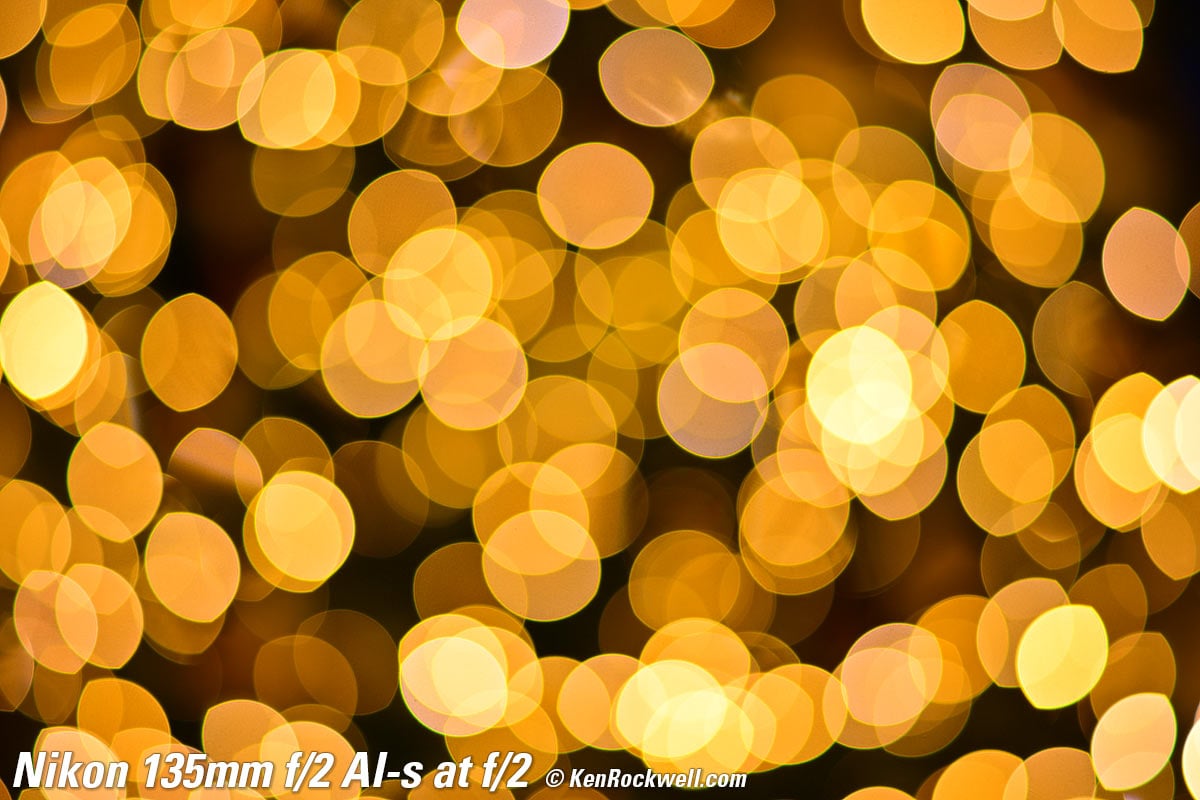 |
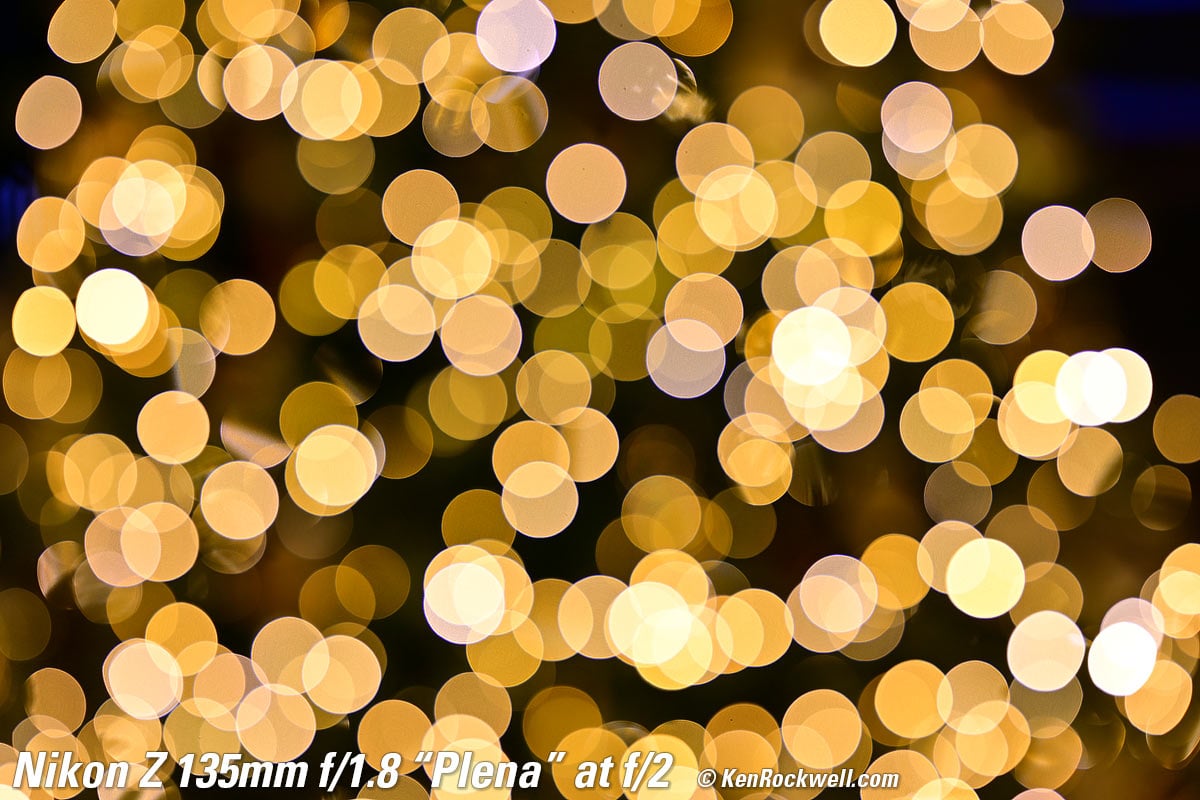 |
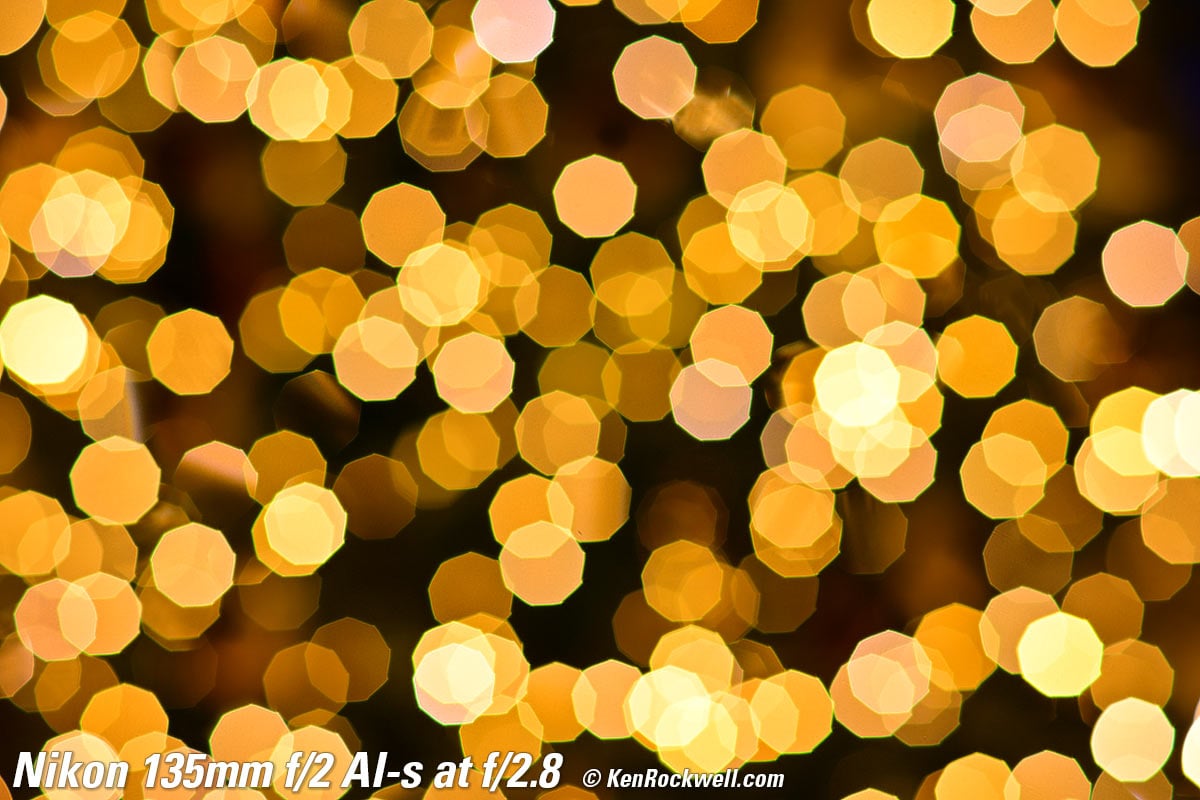 |
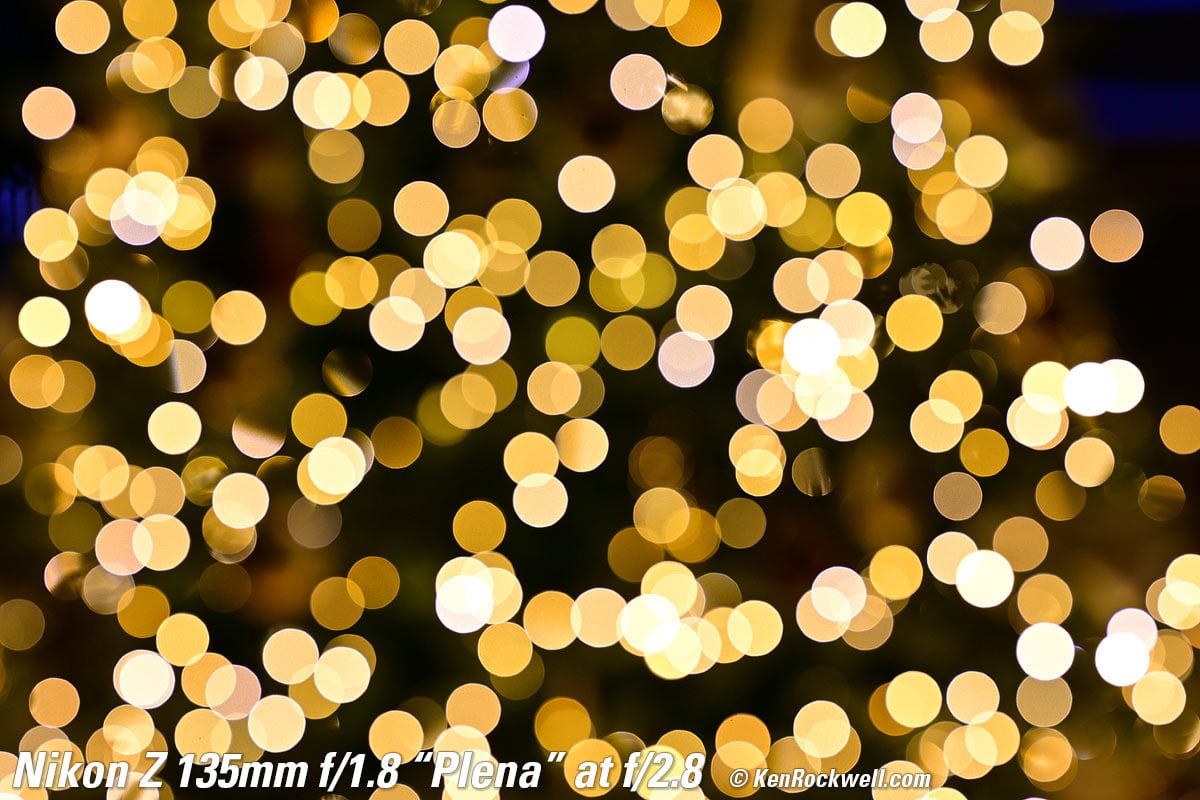 |
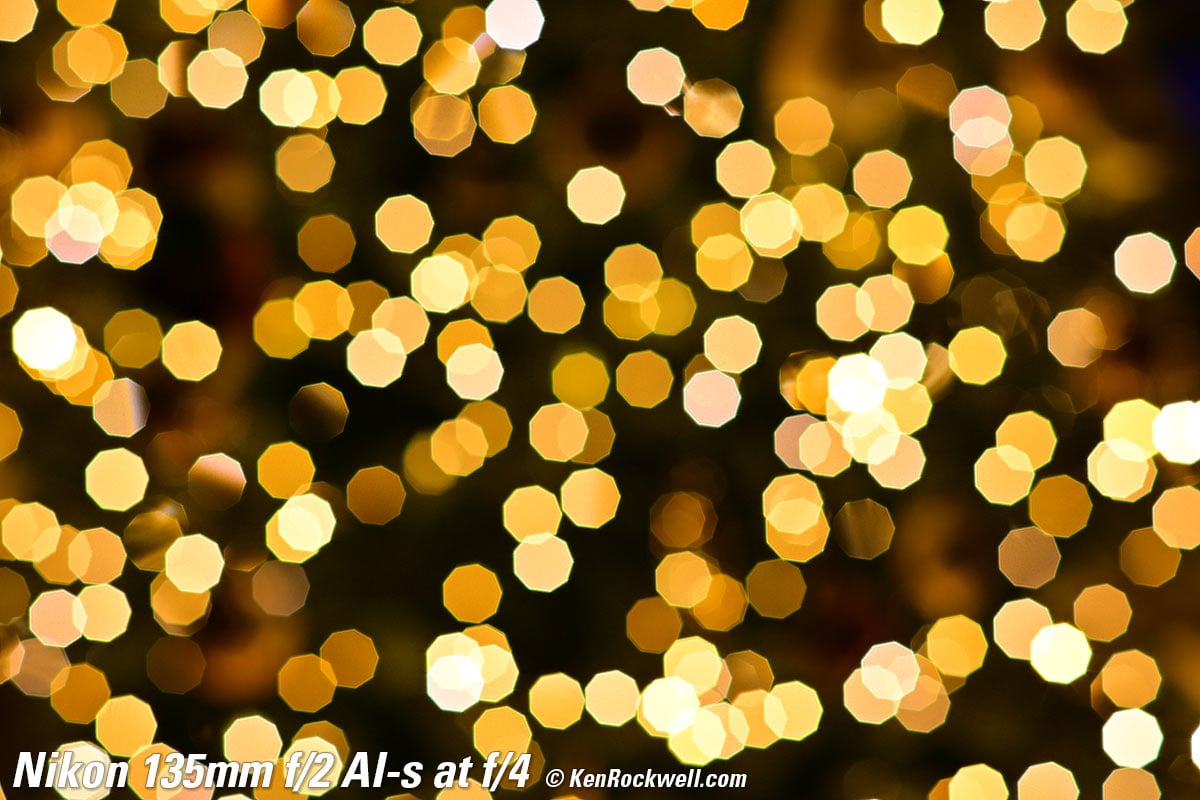 |
|
Do you see what I see? I see that the blur circles from the 135mm f/2 AI‑s are larger than the circles from the Z 135mm f/1.8. How can this be with two fixed 135mm lenses on the same tripod at the same distances?
Easy: while the 135mm f/2 AI‑s is a conventional unit-focus lens which always retains its true 135mm focal length and extends as focused more closely, the Z 135mm f/1.8, like most lenses today, focuses internally and shortens its effective focal length as focused more closely. This optical trick in the Z 135mm f/1.8 lets it focus more closely than the 135mm f/2 AI‑s, but it also means for close subjects that the 135mm f/2 AI‑s retains a longer effective focal length with its correspondingly larger blur circles.
I compared both these lenses focused at infinity, with my tree still at 12 feet (3.6m), and indeed the blur circles are the same size at the same aperture. The blur circles from the classic 135mm f/2 AI‑s become larger than those from this Z 135mm f/1.8 at the same aperture as you focus more closely, while they are the same when the lenses are focused at infinity
What is particularly interesting is that while blur circles from point sources from the classic 135mm f/2 AI‑s have an obviously nonagonal (9-sided) shape at every aperture other than f/2, the Z 135mm f/1.8 retains circular blur circles at every aperture! This is also unusual about this lens, and comes from its rounded 11-blade diaphragm which approximates a circle so well that you can't make out the blades in blur circles.
It's an artistic preference as to whether you prefer the fuller peripheral blur circles of this new lens versus the more eclipsed circles of older lenses. Personally I prefer the darker, more eclipsed versions because this helps direct viewers' attentions towards the subject rather than giving eyes a reason to wander off into the corners.
Corner vignetting goes away in all lenses as stopped down. At f/2.8 vignetting is almost completely gone from the 135mm f/2 AI‑s and it is completely gone from the Z 135mm f/1.8.
At f/4 there is no mechanical vignetting in either lens.
Distortion performance top
The Nikon Z 135mm f/1.8 has no visible distortion as shot with Distortion Correction ON, and pincushion distortion is still just about invisible with Distortion Correction OFF,
At 30 feet (10 meters) I measure a correction factor of -0.1 to use in Photoshop's lens correction filter to JPG images with Distortion Correction ON in my Nikon Zf, and a factor of -1.6 with Distortion Correction OFF.
If you shoot raw data rather than JPG images, whatever software you use to create visible images from raw data may or may not correct the distortion as is done in-camera as JPGs. Nikon's own software probably also corrects this from RAW NEF files, but be warned that other brands of raw processing software probably won't correct the distortion, and Heaven only knows what distortion you may see then.
Ergonomics performance
Nikon Z 135mm f/1.8. bigger. |
Nikon Z 135mm f/1.8. bigger. |
The front rubber ring is just for grip; it doesn't rotate. It's actually very handy for holding the lens without knocking the focus ring, which is always active.
The biggest rubbery ring is focus. It's electronic and always active, bravo!
The two L-Fn buttons are usually focus lock, and can be programmed in your camera to control other things. There are two buttons, one for vertical and one for horizontal shots. No matter how you program them, they each will do exactly the same thing as the other.
The thin rear ring usually controls aperture, and can be programmed in your camera to control other things like ISO, aperture or exposure compensation. The available functions will vary over the years with your camera. Since this ring has no clicks I find it weird to use for any of these things.
Good is that there is a switch for Auto and Manual focus.
There's no switch for in-camera Image Stabilization; you have to set this in a menu if your camera has this.
Falloff performance top
Falloff is invisible with correction at its default of ON.
If you shoot raw data rather than JPG images, whatever software you use to create visible images from raw data may or may not correct the distortion as is done in-camera as JPGs. You're on your own there; I don't bother with raw data.
I've greatly exaggerated the falloff by shooting a gray field and placing these on a gray background, and it's still invisible:
Falloff on full-frame at infinity, correction at its default of NORMAL.
© 2024 KenRockwell.com. All rights reserved. |
Here's more money shots. If you go out of your way to turn off falloff (vignetting) correction, there is still almost no falloff. This is Nikon's promise with "Plena," and it works. There is no significant vignetting even uncorrected at f/1.8. What little you see exaggerated here as gray-on-gray won't be visible in actual photos of real things:
Falloff on full-frame at infinity, correction turned OFF.
© 2024 KenRockwell.com. All rights reserved. |
Filters, use with performance top
There's no need for thin filters. I can use a few standard 82mm filters with no vignetting at any setting on full-frame.
Go ahead and use your standard rotating polarizer and grad filters.
Be careful; a lens this long and fast can be sensitive to poorly made filters. Check any filter your hope to use with this lens for flatness. Hold it over the front of one side of a pair of binoculars or a small telescope. The image should be perfectly sharp with or without the filter. If the filter is even slightly unflat, the image seen through the telescope will look awful!
Flare & Ghosts performance top
This is a complex lens with a lot of elements, and even then it has nearly no ghosts. Bravo!
See examples at Sunstars.
Lens Corrections performance top
If you shoot raw data rather than JPG images, whatever software you use to create visible images from raw data may or may not correct aberrations as is done in-camera as JPGs. You're on your own there; I don't bother with raw data.
Nikon Z cameras correct for any or all of distortion, diffraction and falloff (vignette control), and all of these can be set on or off.
Macro Performance performance top
This lens gets reasonably close.
At f/1.8
It's super-sharp even wide-open at f/1.8:
Casio G-Shock Solar Atomic Watch at close-focus distance, Saturday, 13 January 2024. Nikon Zf, Z 135mm f/1.8 wide-open at f/1.8 at 1/4,000 at ISO 50L, +0.7 exposure compensation (LV 14⅔). bigger or camera-original © file.
1,200 × 900 pixel (5× magnification) crop from above. bigger or camera-original © file.
If this 1,200 × 900 pixel crop is about 3" (7.5cm) wide on your screen, the complete image would print at a large 14 × 21″ (35 × 55 cm) at this same high magnification.
If this 1,200 × 900 pixel crop is about 6" (15cm) wide on your screen, the complete image would print at a huge 27½ × 41¼″ (70 × 105 cm) at this same high magnification.
If this 1,200 × 900 pixel crop is about 12" (30cm) wide on your screen, the complete image would print at a mammoth 55 × 82½″ (1.4 × 2.1 meters) at this same extremely high magnification!
At f/8
Of course it's sharp at f/8:
Casio G-Shock Solar Atomic Watch at close-focus distance, Saturday, 13 January 2024. Nikon Zf, Z 135mm f/1.8 at f/8 at 1/200 at ISO 50L, +0.7 exposure compensation (LV 14⅔). bigger or camera-original © file.
1,200 × 900 pixel (5× magnification) crop from above. bigger or camera-original © file.
The crazy texture really is the surface of the solar cell that is the watch face.
If this 1,200 × 900 pixel crop is about 3" (7.5cm) wide on your screen, the complete image would print at a large 14 × 21″ (35 × 55 cm) at this same high magnification.
If this 1,200 × 900 pixel crop is about 6" (15cm) wide on your screen, the complete image would print at a huge 27½ × 41¼″ (70 × 105 cm) at this same high magnification.
If this 1,200 × 900 pixel crop is about 12" (30cm) wide on your screen, the complete image would print at a mammoth 55 × 82½″ (1.4 × 2.1 meters) at this same extremely high magnification!
Mechanical Quality performance top
Nikon Z 135mm f/1.8 Plena. bigger.
This lens is half plastic on the outside and made overseas, not domestically in Japan. It feels a bit like getting ripped off after paying nearly $2,500 USD, but hey, that's what Nikon users are used to today. This offshoring is one of the reasons I switched to Canon in 2012, who still make almost everything domestically in Japan.
Finish
Mostly black plastic or anodized aluminum.
Hood
Plastic bayonet.
Front Bumper
None.
Filter Threads
Plastic.
Hood Bayonet Mount
Plastic.
Gold ED Band
None.
Front Barrel Exterior
Plastic.
Focus Ring
Rubber-covered plastic.
Mid Barrel Exterior
Section with L-Fn buttons: anodized aluminum.
L-Fn Buttons
Rubberized.
Programmable Rear Ring
Metal.
Rear Barrel Exterior
Anodized aluminum.
Focus Mode Slide Switch
Plastic.
Identity
Printed on the outside around the front of the barrel, also engraved on the top of the barrel near the mount.
Internals
Seem like mostly metal.
Dust Gasket at Mount
Yes.
Mount
Chromed metal, oddly seems like aluminum rather than brass.
Markings
Some painted, some engraved.
Serial Number
Laser engraved on bottom of barrel:
Nikon Z 135mm f/1.8 Plena. bigger.
Date Code
None found.
Noises When Shaken
Minor rattling from the diaphragm.
Made in
Made in Thailand.
Sharpness performance top
Lens sharpness has nothing to do with picture sharpness; every lens made in the past 100 years is more than sharp enough to make super-sharp pictures if you know what you're doing. The only limitation to picture sharpness is your skill as a photographer. It's the least talented who spend the most time worrying about lens sharpness and blame crummy pictures on their equipment rather than themselves. Skilled photographers make great images with whatever camera is in their hands; I've made some of my best images of all time with an irreparably broken camera! Most pixels are thrown away before you see them, but camera makers don't want you to know that.
If you're not getting ultra-sharp pictures with this, be sure not to shoot at f/11 or smaller where all lenses are softer due to diffraction, always shoot at ISO 100 or below because cameras become softer at ISO 200 and above, avoid shooting across long distances over land which can lead to atmospheric heat shimmer, be sure everything is in perfect focus, set your camera's sharpening as you want it (I usually set mine to the maximum) and be sure nothing is moving, either camera or subject. If you want to ensure a soft image with any lens, shoot at f/16 or smaller at ISO 1,600 or above at default sharpening in daylight of subjects at differing distances in the same image.
People worry waaaaay too much about lens sharpness. It's not 1968 anymore when lenses often weren't that sharp and there could be significant differences among them; ever since about 2010 all new lenses are all pretty much equally fantastic.
This lens is ultra sharp and contrasty corner-to corner at every aperture, limited of course by diffraction at f/6. This is a great lens for anything that needs sharp under any condition, especially astronomy.
Nikon's MTF chart wide-open at f/1.8 at 10 cyc/mm and 30 cyc/mm.
Spherochromatism performance top
Spherochromatism, also called secondary spherical chromatic aberration or "color bokeh," is an advanced form of spherical and chromatic aberration in a different dimension than lateral chromatic aberration. It happens mostly in fast normal and tele lenses when spherical aberration at the ends of the color spectrum are corrected differently than in the middle of the spectrum. Spherochromatism can cause colored fringes on out-of-focus highlights, usually seen as green fringes on backgrounds and magenta fringes on foregrounds. Spherochromatism is common in fast lenses of moderate focal length when shooting contrasty items at full aperture. It goes away as stopped down.
Surprisingly it still has a good deal of spherochromatism for such an otherwise advanced lens. I was expecting better, but no:
Mondaine A132.30348.11SBB at close-focus distance at f/2, 13 January 2024. Nikon Zf, Z 135mm f/1.8 at 1/4,000 at Auto ISO 50L (LV 15.0). bigger or camera-original © file.
1,200 × 900 pixel (5× magnification) crop from above. bigger or camera-original © file.
If this 1,200 × 900 pixel crop is about 3" (7.5cm) wide on your screen, the complete image would print at a large 14 × 21″ (35 × 55 cm) at this same high magnification.
If this 1,200 × 900 pixel crop is about 6" (15cm) wide on your screen, the complete image would print at a huge 27½ × 41¼″ (70 × 105 cm) at this same high magnification.
If this 1,200 × 900 pixel crop is about 12" (30cm) wide on your screen, the complete image would print at a mammoth 55 × 82½″ (1.4 × 2.1 meters) at this same extremely high magnification!
Sunstars performance top
With an 11-blade rounded diaphragm only stopping down to f/16, it makes just about no sunstars except at its smallest apertures.
Click any to enlarge:
Click any to enlarge.
User's Guide top
Sample Images Intro New Good Bad Missing
Compatibility Specifications Performance
User's Guide Compared Recommendations
I got my Z 135mm f/1.8 at B&H. I'd also get it at Adorama, at Amazon or at Crutchfield, or used at eBay if you know How to Win at eBay.
L-Fn Buttons user's guide top
By default these are usually set as focus lock buttons.
You can select among various options in your camera at:
MENU > ✎ (pencil icon) CUSTOM SETTINGS MENU > f Controls (set the function of the Lens Fn button).
Both buttons will do the same thing.
Rear Control Ring user's guide top
By default this is usually an aperture control.
You can select among various options in your camera at:
MENU > ✎ (pencil icon) CUSTOM SETTINGS MENU > f Controls (set the function of the Lens Fn Ring).
AF - MF Switch user's guide top
A is autofocus, with instant manual-focus override by turning the focus ring.
M is manual focus, only.
Compared top
Sample Images Intro New Good Bad Missing
Compatibility Specifications Performance
User's Guide Compared Recommendations
The best lens is the one that works properly on your camera.
All these lenses have great optics, but only some of them work properly on any particular camera.
Nikon Z 135mm f/1.8 Plena (plastic 82mm filter thread, 5.5"/140mm long, 35.1 oz./995g, 2.7'/0.82m close focus, 0.20× macro ratio, $2,497).
This lens, the Z 135mm f/1.8 (2023-today), only mounts on Nikon's mirrorless Z cameras.
If you're shooting a Z camera, this is the only lens that works properly, as the other lenses below will not autofocus or work properly on on the FTZ or FTZ II. End of story for Nikon mirrorless; the others can take great pictures but you have to work around the shortcomings of Nikon's grossly inadequate FTZ and FTZ II adapters.
Versus the Nikon AF 135mm f/2D DC
Nikon AF 135mm f/2D DC (metal 72mm filter thread, 4.7'/120mm long, 28.9 oz./818g, 3.6'/1.1m close focus, 0.14× macro ratio, about $575 used if you know How to Win at eBay).
This AF 135mm f/2D DC (1990-2021) works great on FX DSLRs and 35mm SLRs. See Nikon Lens Compatibility for details with your camera; read down the AF, AF-D (screw) column for this lens.
This AF 135mm f/2D DC will NOT autofocus on a mirrorless camera with the FTZ or FTZ II, so you're stuck with manual focus. For autofocus, use it on FX DSLRs and 35mm SLRs as intended.
On a mirrorless camera you're stuck with manual focus because the FTZ and FTZ II lack the autofocus motor Nikon knows we need to focus this lens, and you're further screwed disadvantaged because the crummy FTZ and FTZ II both also lack the ability to flick the diaphragm all the way open for full-aperture manual focus for every shot.
Versus the Nikon 135mm f/2 AI-s
Nikon 135mm f/2 AI-s (metal 72mm filter thread, 3.7'/94mm long, built-in hood, 30.1 oz./854g, 4¼'/1.3m close-focus, 0.13× macro ratio, about $350 used if you know How to Win at eBay).
This manual-focus 135mm f/2 F, AI and AI-s (1975-2005) works great on FX DSLRs and 35mm SLRs. See Nikon Lens Compatibility for details with your camera; read down the AI, AI-s column for this lens.
On a mirrorless camera you're screwed disadvantaged because the crummy FTZ and FTZ II both lack the ability to flick the diaphragm all the way open immediately after each shot for full-aperture manual focusing, and they also lack the encoders and technology to allow mirrorless cameras to control the apertures from the camera properly, as well as not letting them record the correct shooting data in their EXIF.
Obviously I've shot this lens on mirrorless for comparison above, however outside of a laboratory environment it's so inconvenient that as an experienced shooter I wouldn't bother with it.
Versus the Canon RF 135mm f/1.8 L IS USM
Canon RF 135mm f/1.8L IS USM (plastic 82mm filter thread, 5.1"/130mm long, 32.8 oz./931g, 2.3'/0.7m close focus, 0.26× macro ratio, $2,099).
This Canon RF 135mm f/1.8L IS USM (2022-today) adds image stabilization which none of the other lenses have and focuses closer than any of the others, however it won't work on any Nikon. Actually I love the Canon mirrorless cameras much more than Nikon; the R6 II is my very favorite camera of any kind as of January 2024, but you probably weren't asking.
Recommendations top
Sample Images Intro New Good Bad Missing
Compatibility Specifications Performance
User's Guide Compared Recommendations
I got my Z 135mm f/1.8 at B&H. I'd also get it at Adorama, at Amazon or at Crutchfield, or used at eBay if you know How to Win at eBay.
This is a big lens for guys with big dreams. This 135mm f/1.8 is superb for astronomy and special low light shooting, as well as anything for which you need beautiful bokeh. It's a big lens with big performance; you;re going to love the three-dimensional effect an ultra-sharp subject takes on set against a velvety-soft background.
It's awfully big for carrying around for daily shooting.
For great headshots and portraits I prefer longer lenses like the Z 100-400mm, but we each have our own style.
I use a clear (UV) protective filter instead of a cap (exactly like an iPhone) so I'm always ready to shoot instantly. I only use a cap when I throw this in a bag with other gear without padding — which is never. The UV filter never gets in the way, and never gets lost, either.
The very best protective filter is the 82mm Hoya multicoated HD3 UV which uses hardened glass and repels dirt and fingerprints. The Nikon NC 82mm is also an excellent choice, but not as resistant to the environment, fingerprints and physical abuse as the HD3 UV.
For much less money, the Hoya multicoated 82mm UV is also optically superb, but the Hoya HD3 is the toughest.
Any of these filters protects as well and gives ultrasharp images, but since filters last a lifetime, you may as well get the best since the Hoya HD3 is tougher and stays cleaner than the others since it repels oil and dirt.
The Nikon 82mm Polarizer is superb.
All these filters are just as sharp and take the same pictures, the difference is how much abuse they'll take and stay clean and stay in one piece. Since filters last a lifetime or more, there's no reason not to buy the best as it will last you for the next 40 years. Filters aren't throwaways like digital cameras which we replace every few years, like it or not. I'm still using filters I bought back in the 1970s!
I'd get my Z 135mm f/1.8 at B&H, at Adorama, at Amazon or at Crutchfield, or used at eBay if you know How to Win at eBay.
This 100% all-content, junk-free website's biggest source of support is when you use those or any of these links to my personally approved sources I've used myself for way over 100 combined years when you get anything, regardless of the country in which you live — but I receive nothing for my efforts if you get it elsewhere. Nikon does not seal its boxes in any way, so never buy at retail or any other source not on my personally approved list since you'll have no way of knowing if you're missing accessories, getting a defective, damaged, returned, dropped, incomplete, gray-market, store demo or used lens — and all of my personally approved sources allow for 100% cash-back returns for at least 30 days if you don't love your new lens. I've used many of these sources since the 1970s because I can try it in my own hands and return it if I don't love it, and because they ship from secure remote warehouses where no one gets to touch your new lens before you do. Buy only from the approved sources I've used myself for decades for the best prices, service, return policies and selection.
Thanks for helping me help you!
Ken.
© Ken Rockwell. All rights reserved. Tous droits réservés. Alle Rechte vorbehalten. Alla rättigheter förbehållna. Toate drepturile rezervate. Ken Rockwell® is a registered trademark.
Help Me Help You top
I support my growing family through this website, as crazy as it might seem.
The biggest help is when you use any of these links when you get anything. It costs you nothing, and is this site's, and thus my family's, biggest source of support. These places always have the best prices and service, which is why I've used them since before this website existed. I recommend them all personally.
If you find this page as helpful as a book you might have had to buy or a workshop you may have had to take, feel free to help me continue helping everyone.
If you've gotten your gear through one of my links or helped otherwise, you're family. It's great people like you who allow me to keep adding to this site full-time. Thanks!
If you haven't helped yet, please do, and consider helping me with a gift of $5.00.
As this page is copyrighted and formally registered, it is unlawful to make copies, especially in the form of printouts for personal use. If you wish to make a printout for personal use, you are granted one-time permission only if you PayPal me $5.00 per printout or part thereof. Thank you!
Thanks for reading!
Ken.
